Author: Colin Harper, Hashrate Index
Chinese report release: Wu Shuo Blockchain
Abstract
It has been more than two years since the Chinese Bitcoin mining ban and the large-scale migration of hashpower. Since the Chinese government drove most of the industry's business overseas, the Bitcoin mining industry has undergone irreversible changes.
After this historic event, the profitability of mining soared, and miners calculated their "good luck" through this brief "super cycle of hashpower prices," followed by a dark period of hashpower prices during the bear market in 2022. In November of last year, the price of the coin reached $15,000, and a few mining industry commentators speculated that the price could reach $30,000 by mid-2023. But Bitcoin was born to disrupt people's expectations.
Now, two years have passed since the mining ban, and the Bitcoin mining industry has matured significantly. Undoubtedly, the mining business in 2023 is low-key, tenacious, and transient, but the "shadow play" of Bitcoin mining has ended, and the internal operations of the Bitcoin mining industry have become more transparent compared to the past.
Today, listed mining companies and private mining companies dominate the mining landscape. Especially in North America, with the collapse of mining operations in China, the Bitcoin mining industry has flourished once it made a grand appearance. Moreover, hashpower continues to overflow into new mining centers outside the United States, including Russia, the Middle East, Latin America, and Southeast Asia. The distribution of hashpower on a global scale is more balanced than ever before.
As the industry has evolved from its stumbling early stages to its current maturity, miners are learning from the market chaos of 2022. They are continuously involved in fund management and financing practices, and previously bankrupt mining companies are restructuring with more sound operational strategies and re-emerging.
For the Bitcoin mining market, 2022 was a shocking year, laying the foundation for active participants to stand firm this year. As we approach and pass the Bitcoin halving period in 2024, more fluctuations are expected. Cheap energy is the key to this game, and the purchase of mining machines and fund management are two points of particular concern for miners.
Any measures to reduce costs in the above areas and elsewhere will be crucial to safely navigate the halving period. For some fortunate mining companies, this can be achieved by negotiating lower electricity rates, especially for those large-scale mining companies, and participating in demand response programs; other companies can only reduce machine operating speeds through firmware underclocking to lower electricity costs; some miners are looking for more affordable hardware facilities and logistics costs; and some miners are reducing costs by recovering waste heat. For large mining companies, reducing administrative costs is also crucial.
If so, Bitcoin mining is no longer a "plug-and-play" game. Operators who can obtain the cheapest electricity and/or have effective expansion and operational strategies will be better positioned to survive after the halving by reducing capital and operating costs. Since the ban in China, the axis of the mining industry has shifted from the East to the West, making it easier for North American investors to enter the industry than ever before, and new attention and capital are pouring into this field at an unprecedented rate. In the coming year, some more ordinary investors, especially those with low MOQ hosting transactions, may face challenges.
As the Bitcoin industry continues to grow and becomes closely linked with institutional finance, we expect the integration trend that began in 2021 and accelerated in 2023 to continue. At the same time, Bitcoin's hashpower has never had such a broad global footprint, and we expect Bitcoin's hashpower to continue to spread globally.
North American miners need to remember that they are not only competing with their neighbors, but also facing the booming mining industry in the Middle East, as well as in China, Russia, Latin America, and other regions.
Each region and background has its advantages and disadvantages, and some forward-thinking miners are beginning to diversify their hashpower to different jurisdictions through connections and resources.
In the second quarter of 2023, we saw many miners taking advantage of low mining machine prices for future expansion. The rebound of Bitcoin and the breathing space after the tightening of hashpower prices in 2022 (with enough help) gave miners the opportunity to catch their breath at the bottom of the hashpower prices in 2022. For mid- to high-cost miners who did not profit for most of the fourth quarter of 2022, the rebound in coin prices and the stability of hashpower prices are crucial.
Now that the second quarter has ended, Bitcoin prices have fallen, hashpower has risen, and miners are preparing for the harsh fourth halving era. Building on last year's trend, mergers and acquisitions, integration, and asset consolidation sales are accelerating in 2023, as poorly positioned miners seek exit opportunities, while advantaged miners prepare for expansion. We expect the halving to accelerate these trends.
As the breathing space for hashpower prices in the second quarter gradually comes to an end, with less than eight months left until the halving, the miners' slogan is simple: survive and prepare.
Hashpower, Mining Difficulty, and Hashpower Prices
Hashpower Growth Slows, Mining Difficulty Rises
2023 is an important year for the growth of Bitcoin hashpower (although it did not meet miners' expectations). The hashpower in 2022 grew more than in 2021 (the year of the Chinese mining ban), and the hashpower growth in 2023 is expected to exceed that of 2022.
However, in the second quarter, hashpower growth slowed, indicating that the secondary effects of the hashpower "migration" are emerging.
It can be seen that the high concentration of hashpower in North America (45-50%) has created a new seasonal impact on Bitcoin hashpower: the summer heat has overloaded the power grids across the United States, forcing miners to reduce mining scales, thereby suppressing the growth of hashpower. Specifically, the seven-day average hashpower of Bitcoin grew by 7.5% in the second quarter of 2023, far less than the 35% increase in the first quarter. This slow growth is mainly due to the summer temperatures interfering with operations in mining hotspots such as the United States. However, it is worth noting that this year's summer hashpower growth has not been significantly affected by the record heat waves of last summer.
Currently, Bitcoin's hashpower has significantly increased in 2023. As of July 22, 2023, Bitcoin's hashpower has increased by 50% compared to the beginning of the year, from 255 EH/s to 380 EH/s.
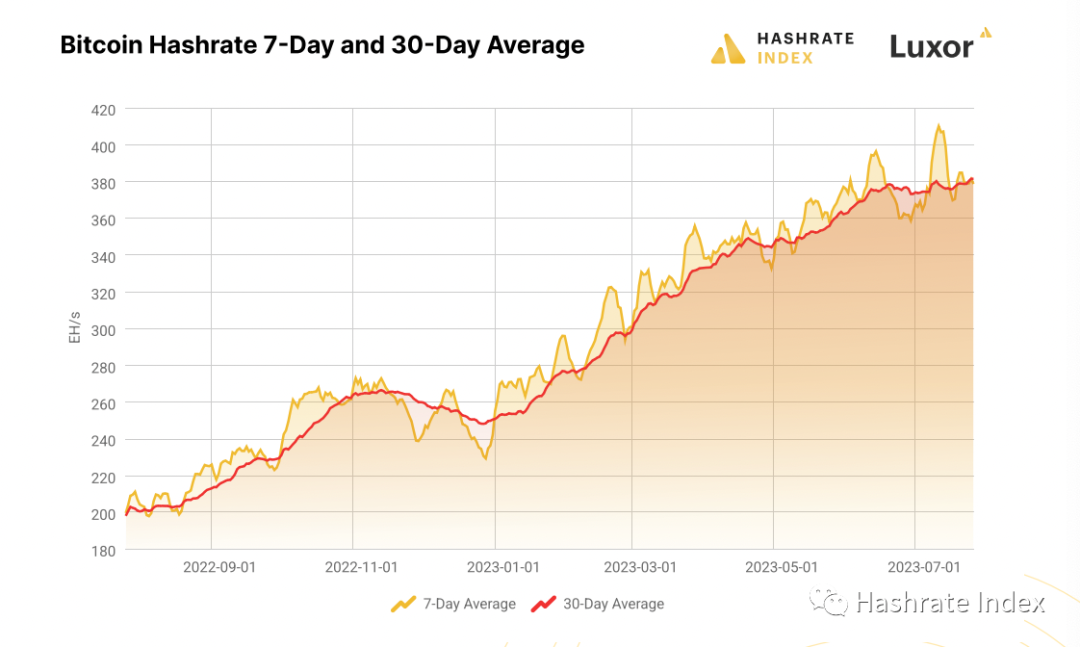
Figure 1: Changes in 7-day and 30-day moving average of Bitcoin hashpower
With the increase in Bitcoin's hashpower, the mining difficulty of Bitcoin increased by 8.1% in the second quarter of 2023 and by 52.5% since the beginning of the year (as of July 22, 2023).
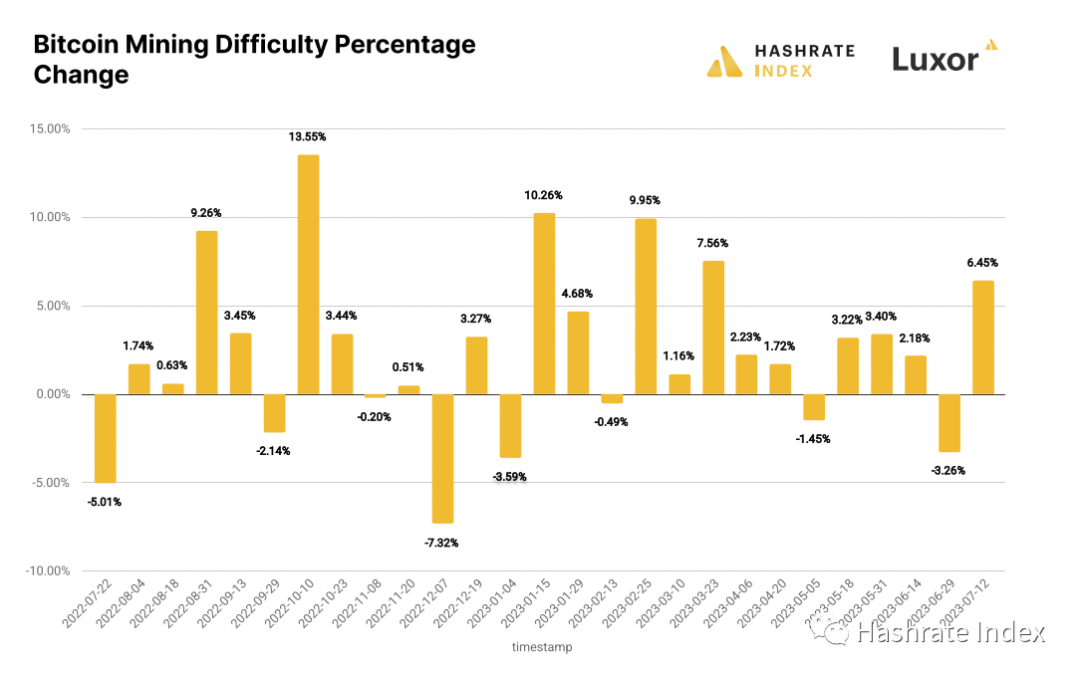
Figure 2: Overview of changes in Bitcoin mining difficulty
After reaching a historical high of 53.91 T, the mining difficulty has decreased by 2.94%. Last summer, due to heat waves ravaging the United States and causing a decrease in hashpower, Bitcoin miners adjusted the difficulty three times in a row. Since the beginning of 2023, miners have largely avoided the summer heat, and the heat waves have not caused much interference with hashpower. However, as we enter August (the second hottest month in U.S. history), if the weather becomes extremely extreme, we may see more negative difficulty adjustments. However, any interference in hashpower can easily be compensated for by the expansion of mining points around the world.
Stagnation of Hashpower after Sharp Increase
Recalling what we mentioned in the year-end report of 2022 (if you are a miner, you don't need to be reminded), the hashpower price hit rock bottom in the fourth quarter of last year. It reversed in the first quarter, providing some relief for miners, and in the second quarter, the hashpower price quickly rebounded and stabilized under the combination of the decline of the NFT craze (which we will further explore in the ordinal and inscription section), the recovery of Bitcoin prices, and slow hashpower growth.
The average hashpower price in Q2 (in USD terms) was $77 per PH/day, a 5% increase from the Q1 average of $72 per PH/day, and a 30% increase from the Q4 average of $59 per PH/day. The average hashpower price in Q2 (in BTC terms) was 0.00275 BTC per PH/day, a 15% decrease from the Q1 average.
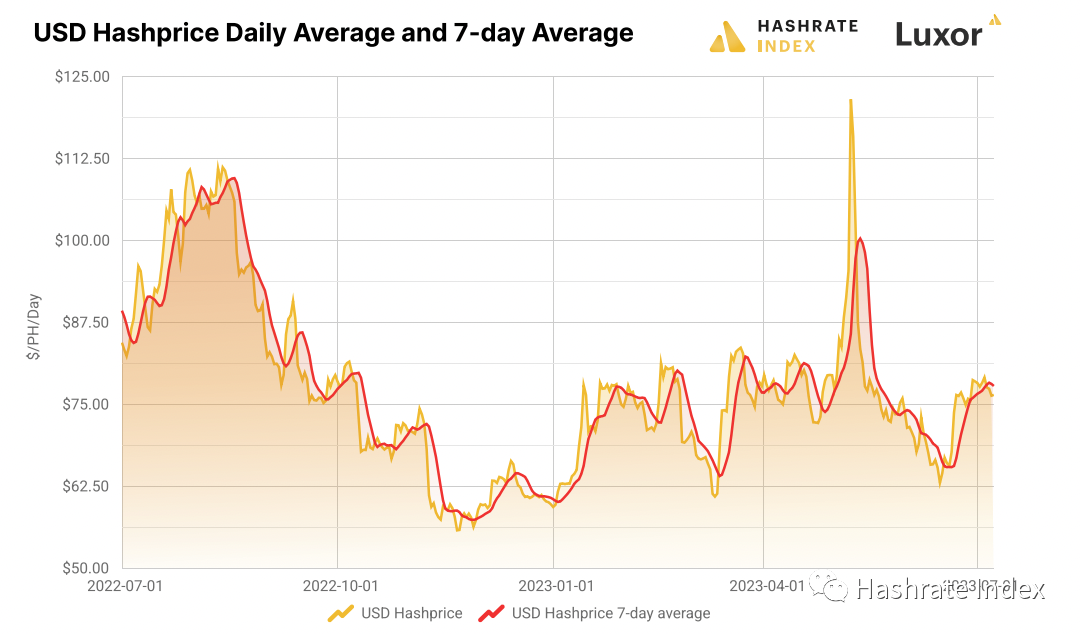
Figure 3: Overview of daily average hashpower prices and 7-day average in USD terms
Overall, Q2 was a feast for miners with scarce profits. Considering that the breakeven point for the S19j Pro mining machine at an electricity cost of $0.07 per KWh is $51.25 per PH/day, it can be imagined how many miners were anxious at the end of 2022 (especially in the North American region). Q1 provided a slight relief for this profit squeeze, and Q2 further alleviated the situation.
However, with the stagnation of Bitcoin's upward trend and the difficulty reaching a historical high in July, pressure has returned to hashpower prices. Currently, the hashpower price in USD terms is $72 per PH/day, and in BTC terms, it is 0.00244 BTC per PH/day.
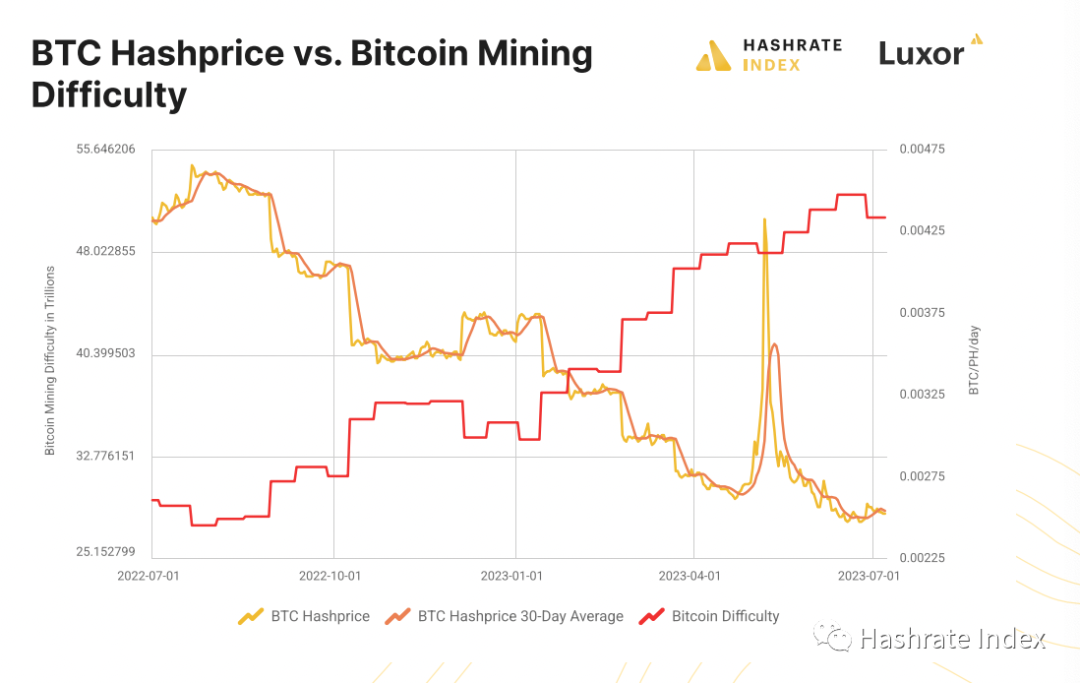
Figure 4: Comparison between Bitcoin hashpower prices and mining difficulty
Ordinal and Inscription: Miners Stop "Internal Strife" and Embrace "jpeg" Format Images
In 2023, Bitcoin miners are reminded that transaction fees will have a huge impact on their bottom line, and they should partly thank the influence of "bored apes" and "Pepe jpegs."
In 2022, transaction fees accounted for 1.63% of all block rewards. In contrast, the proportion of transaction fees so far is 4.9%, 2.3% in Q1 of 2023, and 8.11% in Q3. This increase is not from traditional economic transactions but from a new way of minting and trading NFTs on Bitcoin.
These digital images, videos, texts, and electronic game files, called inscriptions, can be included in Bitcoin transactions using specific transaction conditions. Unlike NFTs on Ethereum, Solana, and other on-chain platforms, these NFTs are actually uploaded to the blockchain. To track them, collectors use ordinal theory, a mathematical method of digital ordering, to mark a single satoshi in each transaction as the "deed" of the inscription. Based on a first-in, first-out basis, ordinal theory can track every satoshi since the genesis block.
Like paper money and coins, collectors also look for rare coins with monetary value, and the inscription craze has opened up a market for "rare satoshis."
The discussion around inscriptions and ordinal theory has led to a surge in block transaction activity on the Bitcoin blockchain, resulting in transaction fees reaching their highest levels since October 2020.
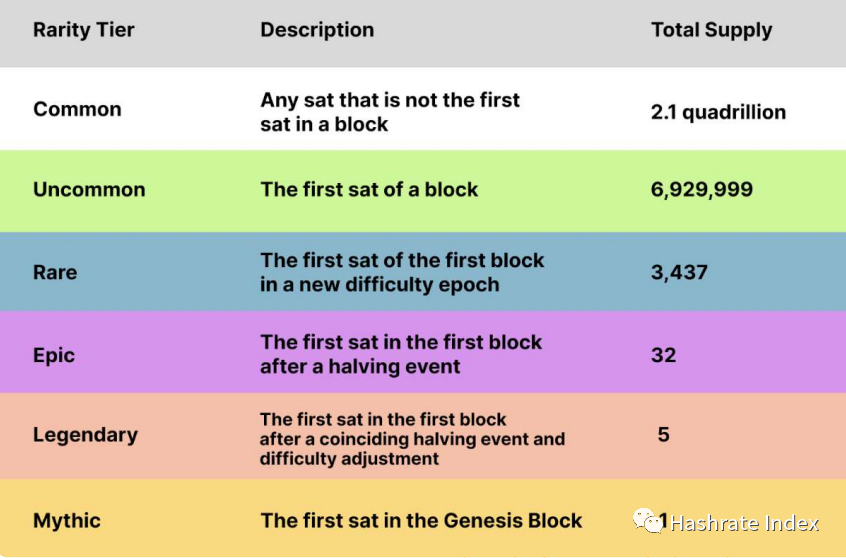
Figure 5: Overview of rare levels of Bitcoin "satoshi"
Ordinal and Inscriptions Lead to Historic High Transaction Fees
Casey Rodarmor first introduced the concept of ordinal and inscriptions in January of this year, although he and others began experimenting with the technology in December of last year.
Inscriptions gained attention in February, and early adopters rushed to inscribe digital art and miscellaneous collectibles. This novel NFT method attracted many NFT traders, collectors, and creators from the Ethereum ecosystem, accelerating the frenzy and the flourishing of transaction fees. As of now, there are over 19.6 million inscriptions on the Bitcoin blockchain.
The adoption of ordinal inscriptions in February immediately doubled miners' income from transaction fees compared to 2022. In 2022, the average share of block rewards from transaction fees was 1.63%; as of now, the average share in Q1 was 2.3%, in Q2 it was 8.11%, and the annual average share is 4.9%.
When the inscription craze peaked in May, miners earned more from transaction fees than from block subsidies, and it became common to have blocks with 12.5 bitcoins or more in rewards, which was the case in the previous halving period.
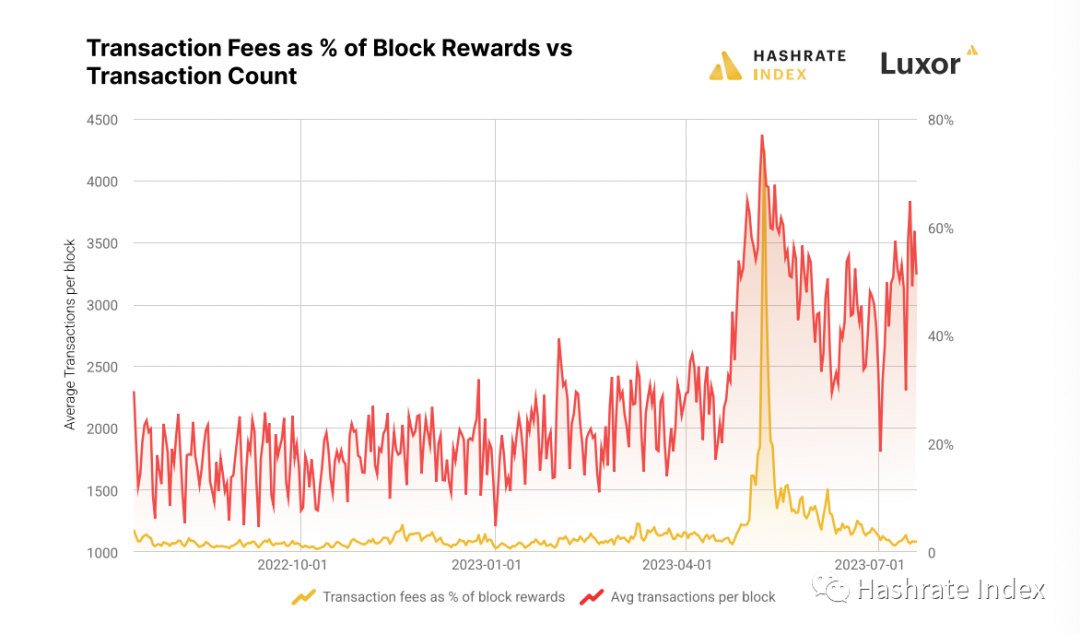
Figure 6: Overview of the proportion of transaction fees to block rewards and transaction volume
Changes in Block Capacity Under the Inscription Craze
Inscriptions have been controversial for several reasons, one of the main ones being their benefit from the data discount of SegWit. Inscription data is stored in the witness part of the block (introduced through the Segregated Witness (SegWit) upgrade in 2017). Compared to other data blocks in regular transactions, witness data has a lower cost per byte for transmission, resulting in lower transaction costs (satoshi) per byte of data when inscribing transactions. The final effect of the SegWit discount can be seen in the graph below, showing the difference between transaction volume and block size from February to May, which well illustrates the impact of the witness discount on early inscription fee dynamics. Blocks were filled with inscription data (such as images and text), but the transaction volume (which increased) did not increase at an astonishing rate.
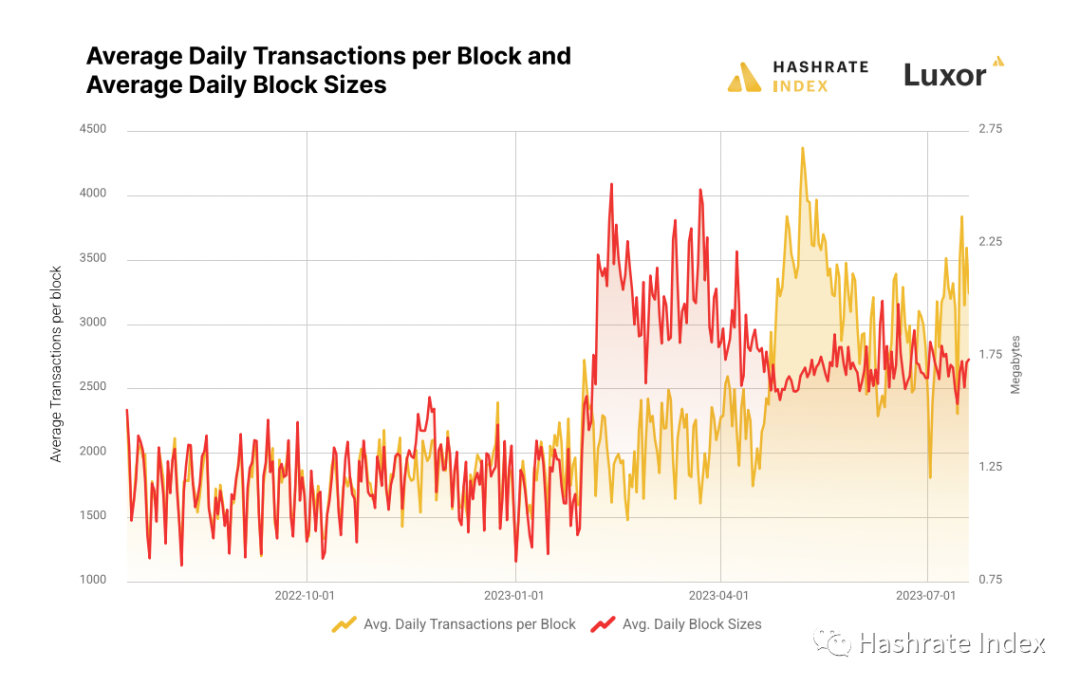
Figure 7: Daily average transaction volume per block and daily average block size
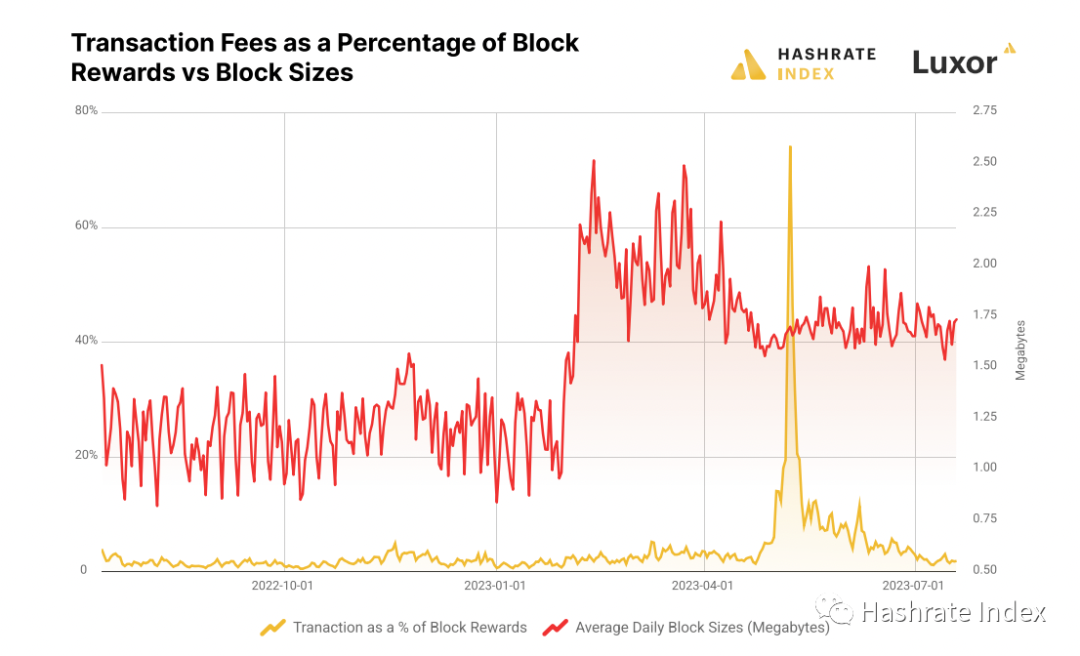
Figure 8: Overview of the proportion of transaction fees to block rewards and block size
In the second quarter, "BRC-20 tokens" dominated the inscription market, and the number of inscription transactions and actual transaction fees began to rise. Initially, most inscriptions were in JPG and other image formats, but BRC-20 transactions require less witness space and more transaction field space, incentivizing a completely different level of transaction activity.
As shown in the graph below, transaction activity accelerated in April, reaching its peak in early May.
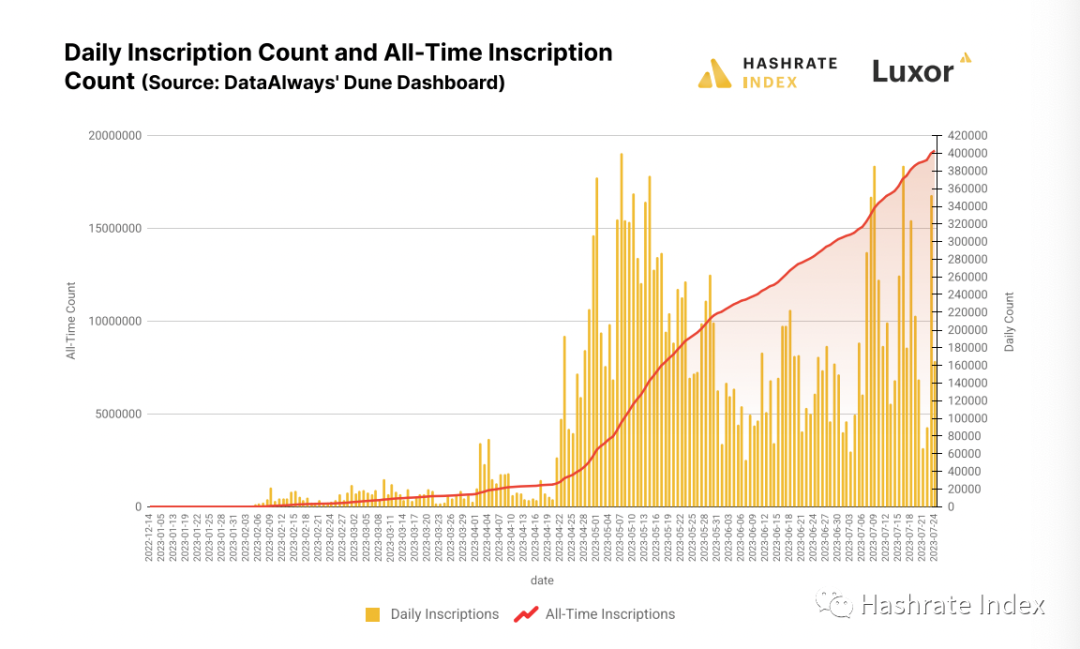
Figure 9: Daily average inscription transaction volume and total transaction volume
The BRC-20 token standard was introduced in April 2023, ultimately bringing the minting craze similar to Ethereum to the inscription field. Before this, inscription creators would mint an entire collection and then auction it off in a very basic over-the-counter manner on Discord servers, Twitter, and other forums; unlike popular NFT collectibles on other blockchains such as Ethereum and Solana, users could mint their own NFTs from the auctioned collection, but this option did not exist for inscription collectors.
The BRC-20 standard changed this. Now, using Bitcoin's OPCODE field, collection creators can create tokens with fixed supply parameters. After the template is broadcast, anyone can mint tokens from the series according to the token's parameters. When BRC-20 gained popularity in May, the first-come, first-served mechanism encouraged inscription creators to bid fees, competing for the opportunity to be the first to mint tokens from a new series. These minting transactions are also OPCODE transactions, so they do not benefit as much from the SegWit discount, as the cost per byte is higher.
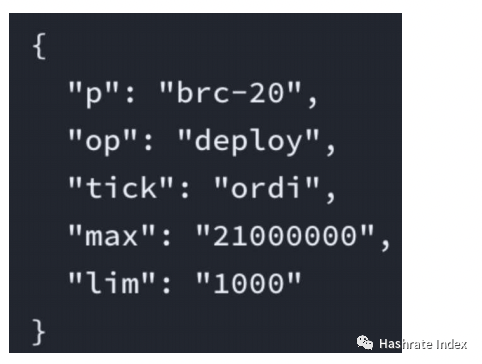
Figure 10: BRC-20 OPCODE example_
This minting incentive and BRC-20 transactions not benefiting as much from the SegWit discount led to the significant increase in transaction fees in May, as shown in the graph below. We also observe that minting activity stabilized in July after experiencing a parabolic increase in May.
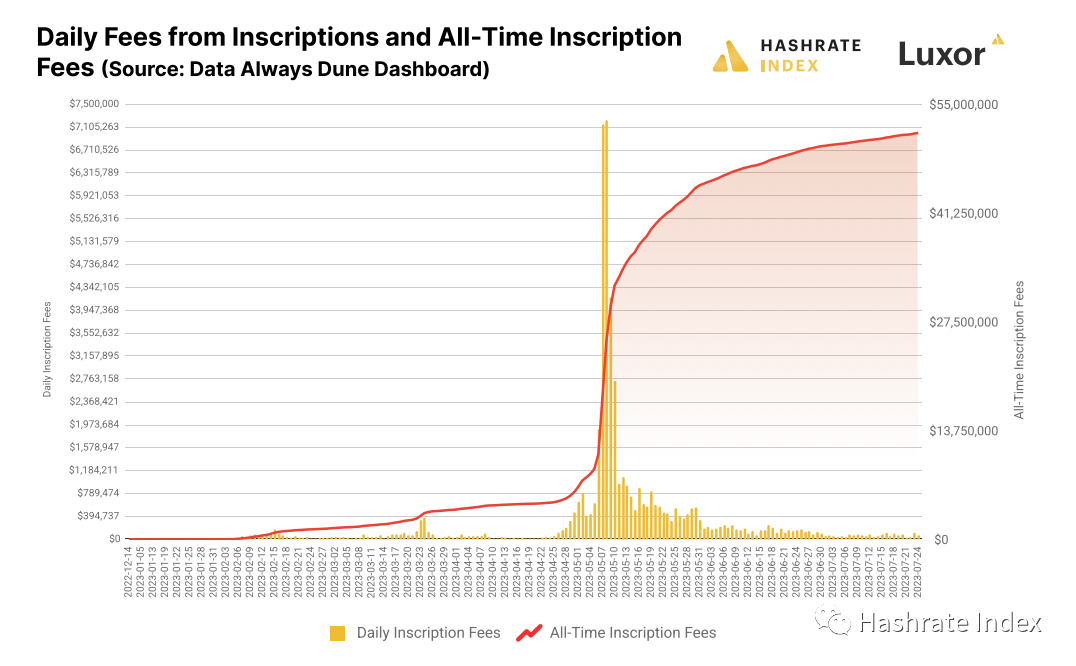
Figure 11: Daily average inscription transaction fees and total transaction fees
The first wave of NFT craze on Ethereum appeared in the form of CryptoKitties in 2017, but it wasn't until the historic bull market in 2021 that NFTs truly began to have a significant cultural impact. For example, Eminem and Snoop Dogg portrayed bored apes in a virtual performance at the MTV Video Music Awards (VMAs). NFTs have started to integrate into people's daily lives, not to mention their impact on miner income.
We expect that ordinal inscriptions will have a similar continuity and will create cyclical periods of transaction fee prosperity and downturn, especially in bull market conditions, particularly when interest in Bitcoin and cryptocurrencies is high.
However, this does not mean that miners should bet on inscriptions to keep hashpower prices stable. We believe that digital collectibles have captured cultural consciousness, and the inscription trend is expected to increase miner income in the future, especially as developers and entrepreneurs begin to experiment with new applications using block space.
Stabilizing Trend in Mining Machine Prices
Since the end of the bull market in December 2021, Bitcoin mining machine prices have been on a free fall, but in the third quarter of 2023, there seems to be signs of a slight rebound, at least for now.
Overall, prices are still on a downward trend, but market data shows signs of stabilizing in July, especially for the new generation of devices. Below, we list the quarterly changes in prices for some popular mining machine models (data from Luxor's mining machine trading platform RFQ).
- S19 XP (-2.64%)
- S19j Pro+ (2.07%)
- M30S++ 112TH/s (-10.34%)
- S19 Pro 110 TH/s (-15.63%)
- S19j Pro 104TH/s (-16.88%)
- M30S 88TH/s (-25%)
It is clear to see that newer models with lower hashpower, such as S19 and M30S, are gradually falling out of favor, while the premium for newer models like S19 XP is rising (as miners seek more efficient machines to prepare for the halving period).
The chart below also shows the changes in mining machine prices in the second quarter of 2022. Despite the decline in Bitcoin mining machine prices in the second quarter of 2022, there was a rebound in June and July, especially for the aforementioned next-generation models.
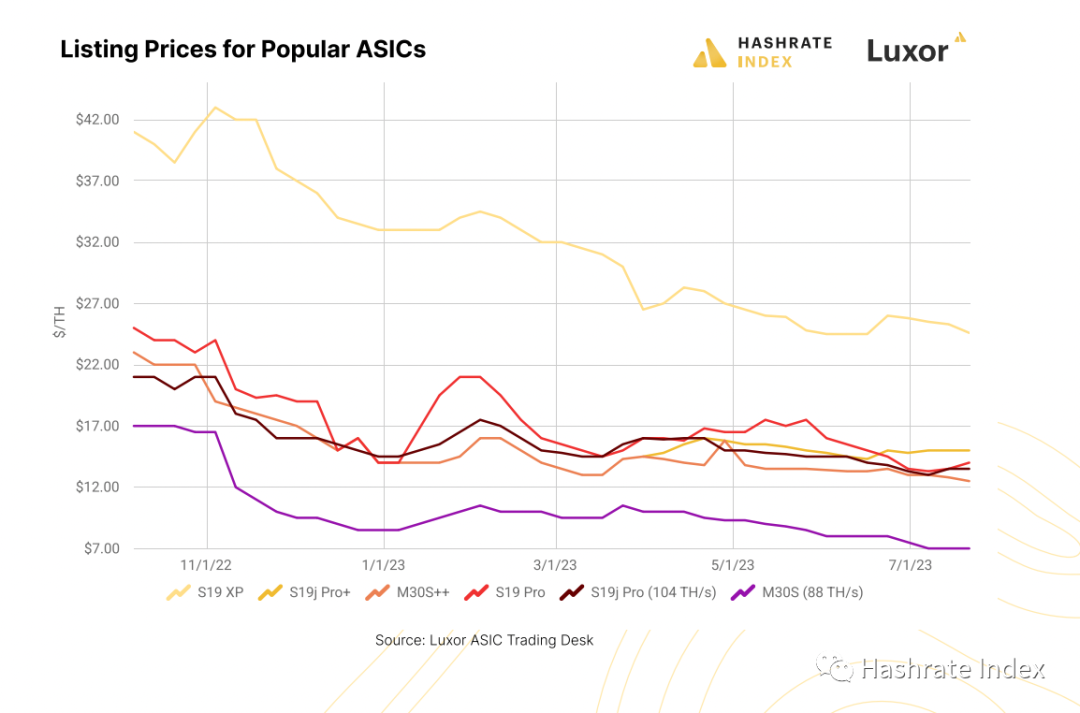
Figure 12: Price trends for popular models
It is worth noting that relative to other S19j series models, the S19j Pro+ appreciated at the end of the quarter, with a premium per TH. S19j Pro+ has just been released, and like previous new machines, the price was lower when miners placed futures orders and the performance of the machine was unknown. As miners gradually observed the operation of the S19j Pro+ and trading shifted from the futures market to the spot market, as uncertainty faded and the model became more transparent, the machine price rebounded. We also saw this pricing dynamic in the S19XP that was released last summer.
It is worth noting that newer generation devices such as S19j Pro, S19 Pro, and M30S++ are currently in tight trading. For most operators, older models in these series, such as the regular S19 and M30S, are becoming less popular, as can be seen from the price drop of M30S in the graph (when the hashpower price hit its historical low in November 2022, the value of M30S plummeted).
For miners operating at electricity costs equal to or higher than the average electricity price (e.g., $0.075/KWh), any model with an efficiency value lower than 34 J/TH is not worth investing in (unless Bitcoin skyrockets in the next 12 months, which we are not betting on, as further analysis in the section on mining machine payback periods in this report). With the Bitcoin halving in 2024 and the introduction of a large number of new machines in 2023 and 2024, yesterday's next-generation machines will become tomorrow's mid-generation machines. However, based on the price per TH, investing in mid-generation and new-generation machines may be a strategy to double profits, provided there is a bull market in 2024/2025. Just as miners bought S9s for a few cents and sold them for $50/TH at the peak of the 2021 bull market.
Rising Premium for S19XP
When miners are expanding their mining operations in preparation for the 2024 Bitcoin halving, hashpower prices and Bitcoin prices are not the only factors miners consider when evaluating mining hardware. Bitmain and MicroBT have released several new models in 2023, and like all new hardware, miners are uncertain about their performance. As the flagship of Bitmain's next-generation miners, the Antminer S19 XP has been in field testing for a year, but there are still some areas that need improvement in its design (such as covering one side of each hash board with an aluminum panel, as reported by Compass's Mining Memo), but miners generally consider it a stable machine.
As the halving approaches, miners are prioritizing machines with advantages in efficiency and hashpower. Therefore, the premium for next-generation hardware such as the Antminer S19 XP and Whatsminer M50S++ is rising compared to older models.
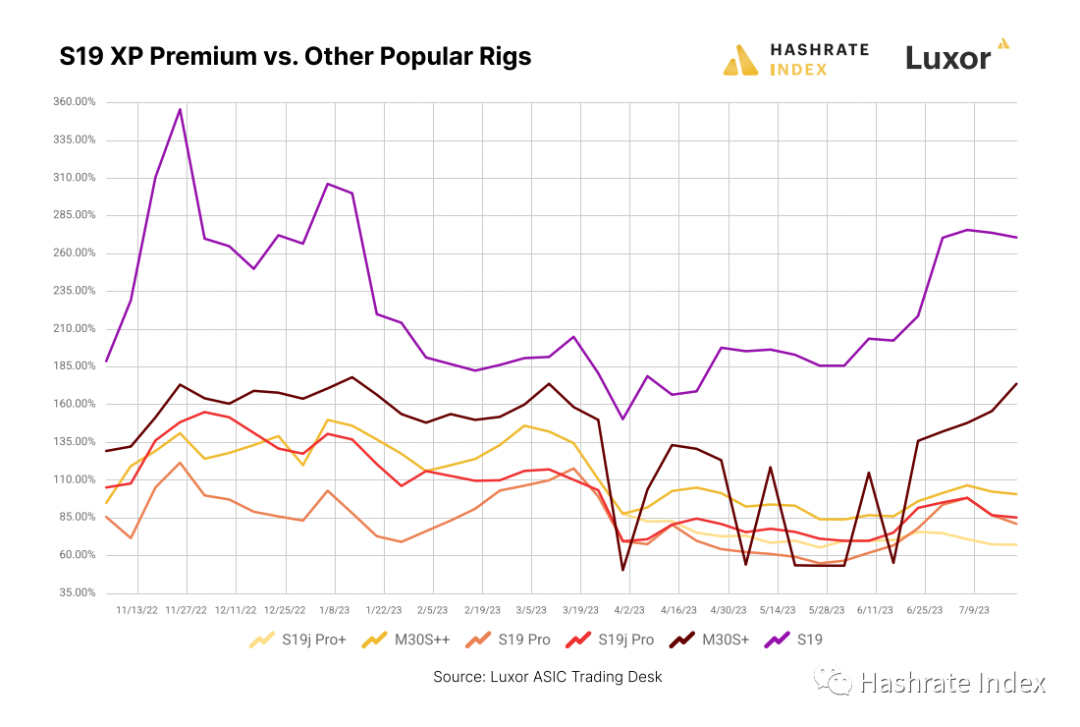
Figure 13: Comparison of premiums for S19XP and other models
As shown in the above figure, the premium for the S19 XP reached its lowest point in the second quarter but has been on the rise since June. As we enter the third quarter, the premium for the S19 XP is approaching the high levels seen at the end of last year, when Bitcoin's price was between $15,000 and $16,000, and every analyst was calling for a correction. With Bitcoin rapidly recovering in the second quarter and the surge in transaction fees under the inscription craze, hashpower prices have been rising, and the relatively low premium in the previous quarter is a response to the improvement in market dynamics. As mining marginal costs improve, miners do not urgently need to switch to more efficient hardware, so the premium for the XP is also decreasing. Now, hashpower prices have returned to uncertain levels, especially with 9 months until the halving, and miners are increasingly inclined to reference post-halving mining economics, leading to another increase in the premium.
We also note that the premium for the M50S series is higher compared to the Antminer S19 XP. We speculate that there are two reasons for this premium: 1) Bitmain produces more machines than MicroBT, so they can obtain better prices from chip manufacturers, and 2) Whatsminer is becoming a strong competitor to Antminer.
As miners prepare for the halving, next-generation models have become their preferred choice. Their premiums have steadily increased over the past year.
New Models and 3nm Chips Coming in 2024
There are reports that Bitmain's next-generation Bitcoin miner, the S21 series, may be released next year. The Antminer S21 was originally planned for release in 2025, but it may be available for pre-order next year. The efficiency of these machines is expected to be 14-15 J/TH, but their exact specifications and hashpower are currently unknown. This is just a rumor at the moment, but it is clear that Bitmain is developing a new Antminer series that is more efficient and powerful than the current models.
Although it is speculative, we believe that these devices will use 3nm chips, as it has been reported that MicroBT has already used 3nm Samsung chips in the Whatsminer M56s++ immersion-cooled model.
Stable Situation in the Electricity Market
In 2023, the electricity market seems to be gradually returning to normal, especially in many states in the United States, where electricity prices have been declining from their peak in 2022. Bitcoin miners around the world can finally breathe a sigh of relief as prices are gradually returning to normal, and at least in public forums and media reports, the industry is now paying relatively less attention to this topic.
Although the situation looks better than last year, miners should still remain cautious and not assume that they have seen the end of the energy crisis. There is still a significant imbalance in the global energy market, which is likely to lead to another increase in electricity prices, especially in extreme weather conditions.
This chapter will discuss energy market trends that may have a positive or negative impact on miners' access to cheap electricity. Based on historical data and future forecasts, we will also analyze the electricity prices that miners will need to calculate hashpower after the halving.
Natural Gas Prices Gradually Returning to Normal
In most modern electricity markets, the price of electricity is determined by the marginal production cost of the last easily dispatchable source, usually natural gas power plants. Given the importance of natural gas prices to the electricity market, this section analyzes the current state of the global natural gas market and introduces the latest developments in the international electricity market to better understand future trends.
As seen in the graph below, in the second half of 2022, natural gas prices in Europe and the United States soared to historic highs. As usual, electricity prices also rose, leading to serious issues for the global Bitcoin mining industry that was not hedged. At the end of 2022, the two largest Bitcoin mining hosting providers in North America, Compute North and Core Scientific, announced bankruptcy, partly due to the rise in electricity costs.
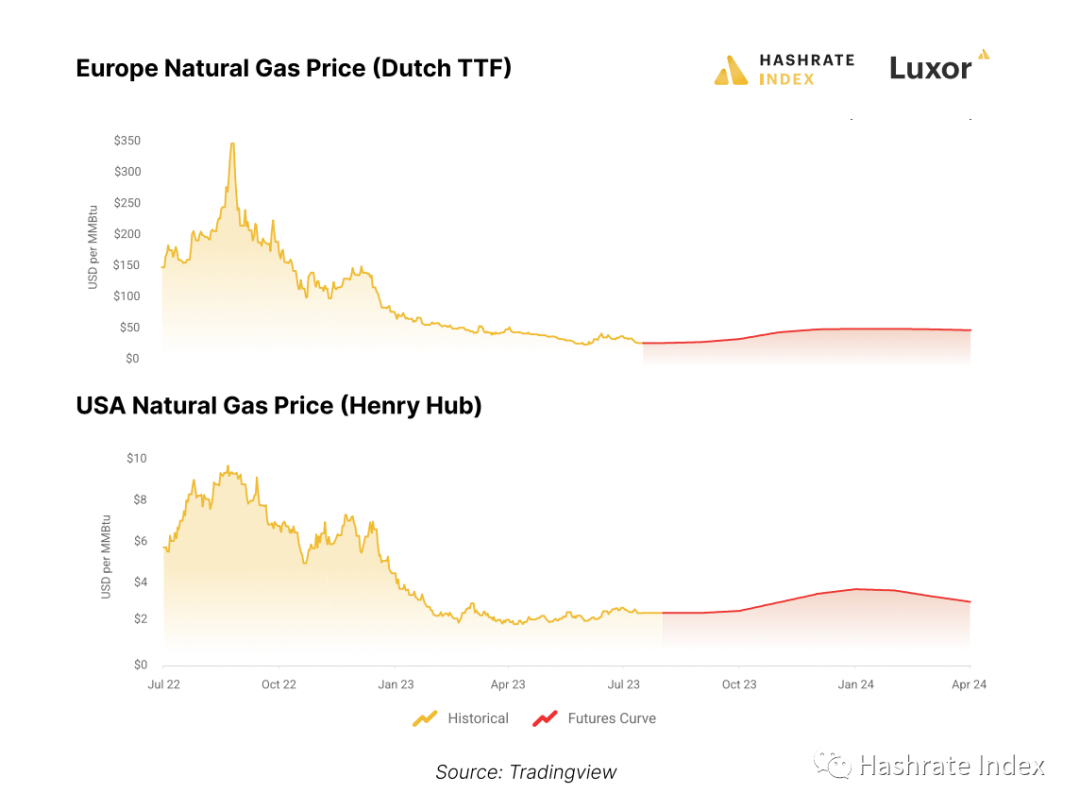
Figure 14: Comparison of natural gas prices in Europe and the United States
Fortunately, Europe experienced the mildest winter in history, leading to a significant decrease in natural gas demand, allowing European countries to replenish their stocks. As a result, the European natural gas benchmark price (Dutch TTF) plummeted and is currently at its lowest inflation-adjusted level since September 2020, at $25.96 per MMBtu, a 93% decrease from the peak of $346 per MMBtu in August 2022.
The U.S. natural gas benchmark (Henry Hub) also experienced a decline, although less than in Europe. Currently, its price is $2.56 per MMBtu, a 73% decrease from the peak of $9.34 per MMBtu in August 2022.
However, according to the U.S. Energy Information Administration and market consensus, natural gas prices may slightly increase in the coming months. The U.S. Energy Information Administration expects the Henry Hub price to average $2.80 per MMBtu in the second half of this year, a 10% increase from the current price of $2.56 per MMBtu. This forecast is consistent with market consensus, as indicated by the futures curve in the above graph, which suggests that natural gas prices will slightly increase in the next winter and then decrease in the spring.
Natural gas prices are extremely difficult to predict, and experts believe that they will remain at relatively comfortable levels in the coming months. However, it is important to emphasize that in this era of market volatility, any energy price forecast carries uncertainty. Due to ongoing geopolitical events in Europe and structural energy market issues, predicting natural gas and electricity prices is more complex and unpredictable than ever before.
Therefore, miners should be prepared for the worst-case scenario and ideally hedge their electricity input costs for the coming months and year.
Electricity Prices Falling from Historic Highs in the United States
Natural gas and electricity prices are interrelated, so the trajectory of natural gas is a universal barometer for global electricity prices. In this section, we will delve into the forecasts for industrial electricity prices in various states in the United States.
As shown in the graph below, electricity prices in most states in the United States have significantly decreased over the past year.
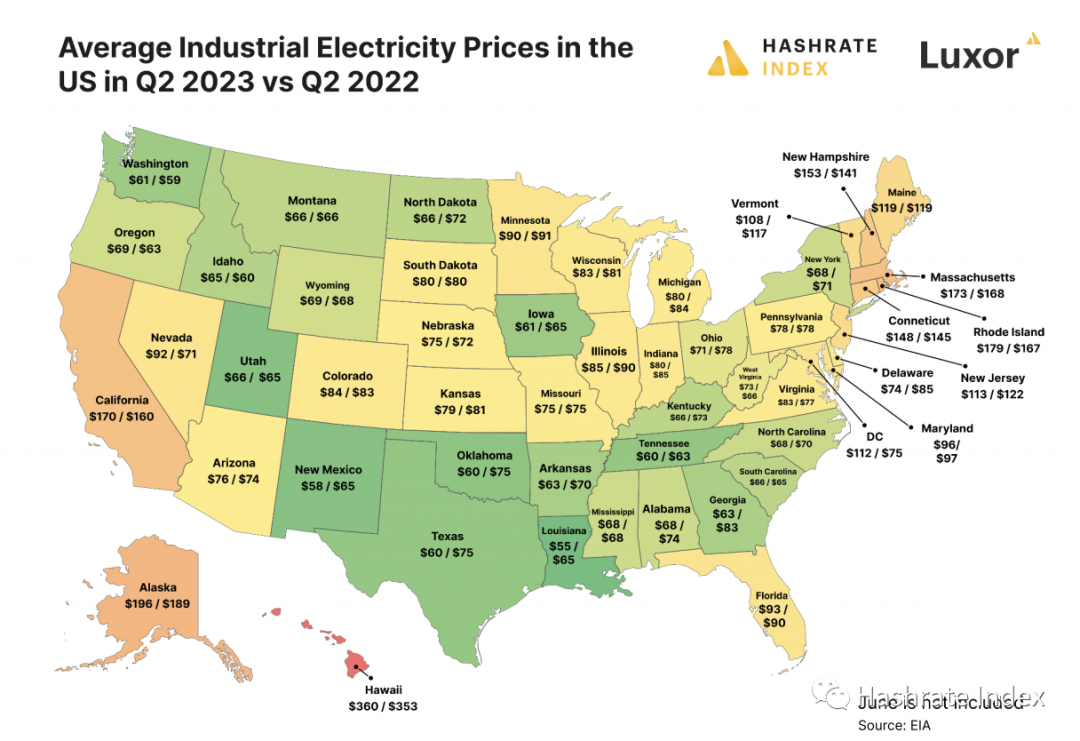
Figure 15: Comparison of average industrial electricity prices in US states for Q2 2023 and Q2 2022
In many states, the decrease in natural gas prices has been helpful, and the summer of 2023 has been more tolerable than the record-breaking high temperatures of the previous year. As we will discuss later, hosting rates have either decreased or remained stable in various states based on electricity prices.
Speculation on Future Industrial Electricity Prices in US States
The polarization between political parties means that energy policy is inevitably caught in the crossfire of the culture war, just like every other topic from affirmative action to new Barbie movies. Generally (Texas being a notable exception), red states prioritize fossil fuels and nuclear base load, as well as hydroelectric power (where meaningful) over renewable energy. Meanwhile, blue states, especially California and New York, prioritize renewable energy such as solar and wind over nuclear and natural gas.
Analysis of the Summer Curtailment Situation in Texas
Summer is the most challenging season for North American Bitcoin miners for two reasons. Not only is there an increased demand for cooling during the summer heat, but spot electricity prices also tend to rise as everyone turns on their air conditioning, and summer is typically a peak season for travel and tourism. These increased electricity prices often force miners to periodically curtail their operations. In this chapter, we will analyze how the summer heat affects mining operations in Texas.
However, in most states, the summer has been relatively mild, despite poor performance of the Texas and California grids during periods of high temperatures and storms.
Fortunately, Texas has so far escaped the worst of the record-breaking heatwave, so miners have curtailed their operations less than expected, except during some specific pressure periods.
In Texas and other electricity markets, there are several drivers of curtailment. A common factor is that miners often curtail their operations during periods of soaring spot electricity prices. As shown in the graph below, the spot electricity prices in the West Texas day-ahead market in July this year have been lower compared to the same period last year.
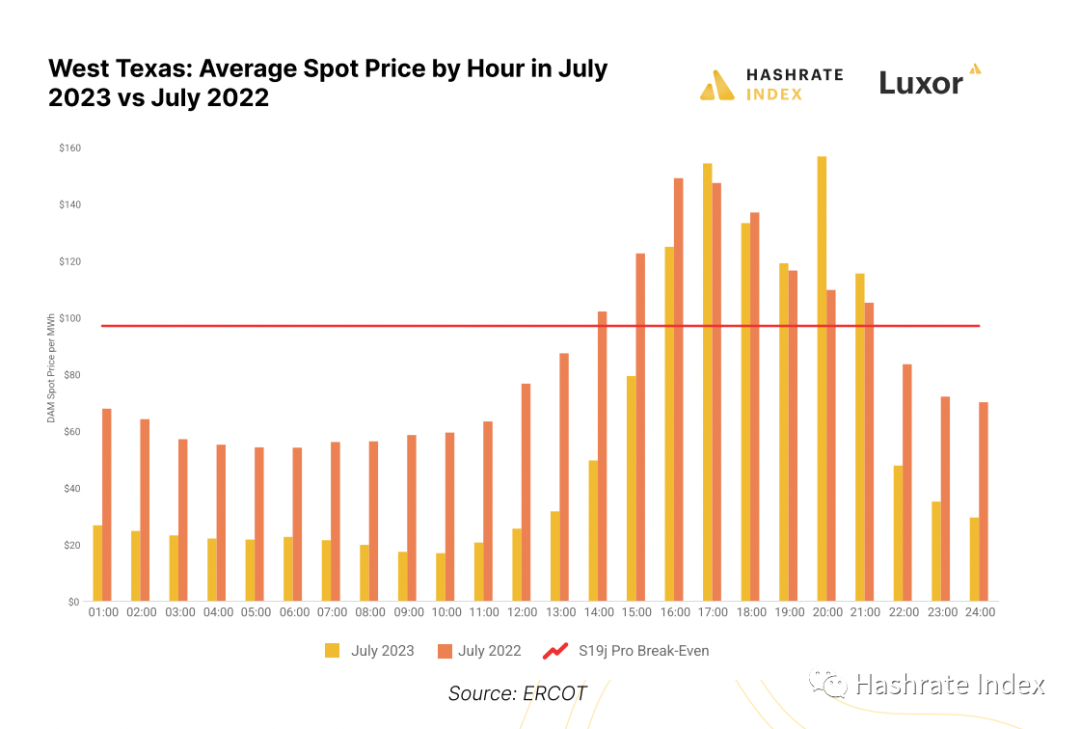
Figure 16: Comparison of average hourly electricity prices in Texas in July 2023 and July 2022
We can see that the average prices between midnight and noon are much lower this summer compared to last year. However, the peak average prices, usually around 5 PM, have been slightly higher this summer compared to last summer.
Most Bitcoin mining in Texas will curtail their load when spot electricity prices exceed the red line of their mining revenue per MWh, as shown in the graph. As we can see, this usually occurs during a six-hour period from 3 PM to 9 PM. A six-hour curtailment means that most Bitcoin miners in Texas can expect to achieve approximately 75% uptime during July.
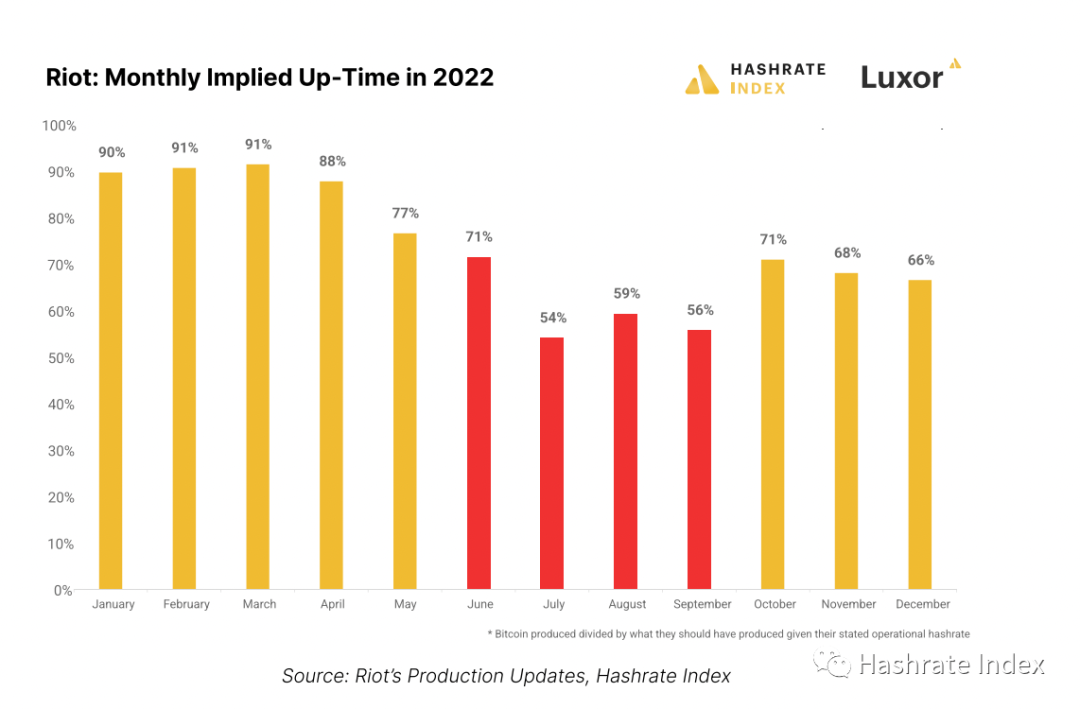
Figure 17: Overview of Riot's monthly machine uptime percentage in 2022
Riot's reduced effective operating time during the summer provides a real case study of ERCOT curtailment. As shown in the above graph, Riot's expected normal operating time from January to April is around 90%. As temperatures and electricity prices rise, the expected normal operating time for this Texas mining giant significantly decreases, operating at only 54% to 71% capacity from June to September. Similar to many other miners in Texas, Riot can significantly reduce its actual electricity costs by reducing its load during peak hours.
1. Different Forms of "Curtailment"
Miners and commentators often talk about "demand response" and "curtailment," and Riot has indeed been compensated for this, while some other large operators in Texas have not, so not all "curtailment" is the same.
ERCOT provides four basic types of curtailment services. (Special thanks to ERCOT's Evan Neel for providing information for this section).
a. Economic Curtailment: This method depends on spot prices in the day-ahead or real-time market. Miners with hedged contracts almost always have the option to relinquish their contracted electricity and have their electricity provider sell it into the spot market. They then settle financially with their electricity provider and receive the difference. This means that for some miners with hedged contracts, curtailing during periods of high spot prices is the best financial interest, even though they are already profitable mining at a fixed price. Their curtailment is because arbitrage opportunities exceed mining revenue. Non-hedged miners operate in a similar manner, but without the arbitrage. If spot electricity prices rise above their mining revenue per MWh, they will curtail. By avoiding the most expensive price intervals (times), they significantly reduce their actual electricity costs.
b. 4 Coincident Peak (4CP) Program: This demand response program aims to allocate transmission costs based on the total average consumption during four summer months (January to September) of peak load intervals. By avoiding consumption during these intervals, the load can save a significant amount of money in the long term. Typically, most miners operate conservatively during the summer to avoid consuming power during one of these intervals (usually early afternoon to evening). Most of the summer curtailment by miners can likely be attributed to this.
c. Ancillary Services: Ancillary services are reliability products competitively procured by ERCOT in the day-ahead market. As reliability products, they serve as tools for operators to dispatch to balance the grid. Eligible large flexible loads (LFLs) can participate in these markets if they have uncontrolled load resources or controlled load resources registered with frequency relays. For obligated LFLs, they will receive the market clearing price of the product and are required to maintain a specific MW consumption threshold within the time they are contractually obligated to be flexible with their load (if the grid needs power, they will use it; if not, miners will maintain mining).
d. ERCOT Alert: In cases of energy scarcity (such as Winter Storm Elliott), some LFLs may curtail when ERCOT issues an alert. This type of curtailment is rare and usually occurs in winter, but is almost impossible during the summer.
2. The Summer of 2023 is More "Human" Than Expected
This summer has been milder than expected. August and September are historically hot months in the US, but apparently less so than July. With the hottest months already behind us, the threat of this summer seems to have dissipated for Bitcoin miners in Texas and other parts of the US.
Stable Hosting Prices and Electricity Market in the US
In 2021, even retail miners in the US were able to negotiate all-in hosting rates of $0.07 per kWh. However, these favorable market conditions did not last, as the rise in electricity prices forced co-locators and hosting providers to increase their prices in the third and fourth quarters of 2022.
According to the Luxor Hosting Rate Index, in January 2023, the average retail hosting rate in the US reached a historical high of $0.081 per kWh, very close to the breakeven electricity price for the Antminer S19j Pro at $0.082 per kWh. Fortunately for miners, electricity prices cooled off in the first quarter of 2023, and hosting rates correspondingly decreased. Currently, both electricity prices and hosting rates have stabilized. The average retail hosting rate in the US is now $0.077 per kWh, a 6% decrease from the beginning of the year.
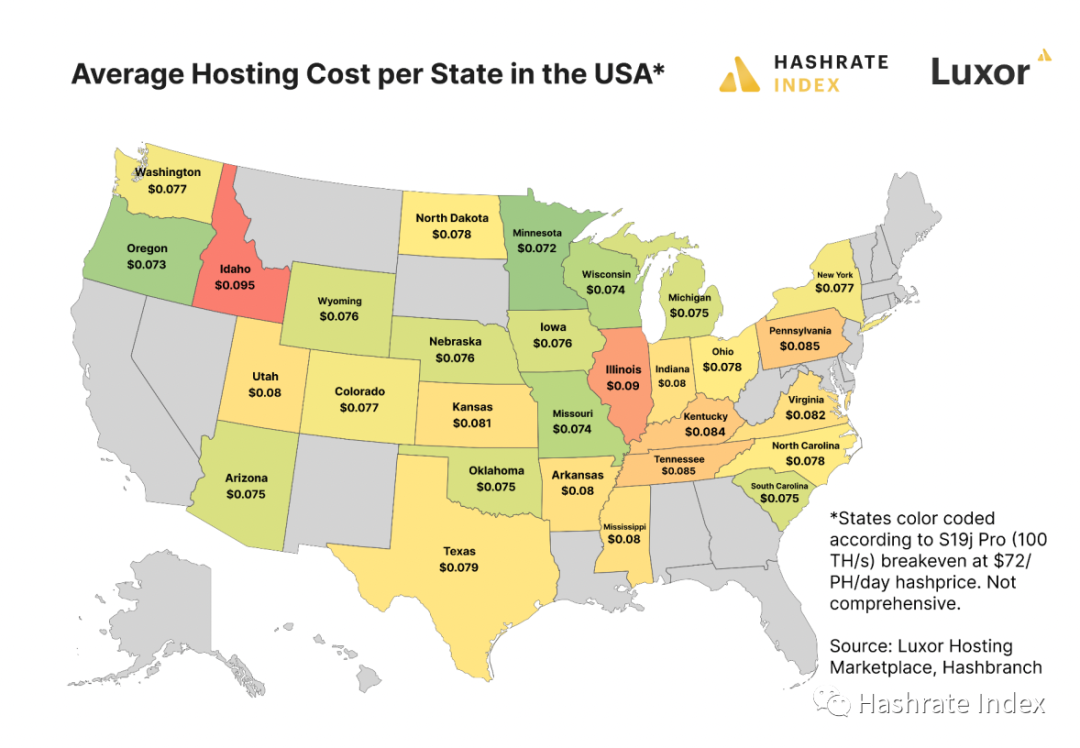
Figure 18: Average hosting electricity prices in US states
As shown in the above graph, hosting service providers in Minnesota, Oregon, Wisconsin, Michigan, Oklahoma, and South Carolina currently offer prices at $0.075 per kWh or below. Idaho and Illinois, on the other hand, are at $0.095 per kWh and $0.09 per kWh, making them the "most expensive states."
It is important to note that our observations for these states are much smaller in scope compared to larger mining states like Texas or Ohio. As shown in the table below, states with more data points often show a larger gap between small MOQ rates and large MOQ rates, as the rack space market is more robust.
Generally, hosting rates will rise or fall based on changes in electricity prices in each state, and states with the most data points can most clearly reflect this correlation. Additionally, hosting service providers are learning from the electricity market fluctuations of 2022; contracts are becoming more flexible, short-term, and subject to monthly adjustments, and long-term contracts of 2-5 years are becoming increasingly rare. More and more hosting providers are signing "pass-through" contracts, which allow them to pass on changes in electricity costs to customers; this is especially common in the oil mining sector, where oil extraction operators have a greater understanding of hashpower price economics and are able to weather periods of rising natural gas prices through balanced contracts on a monthly or quarterly basis.
1. Hosting Electricity Prices in Canada
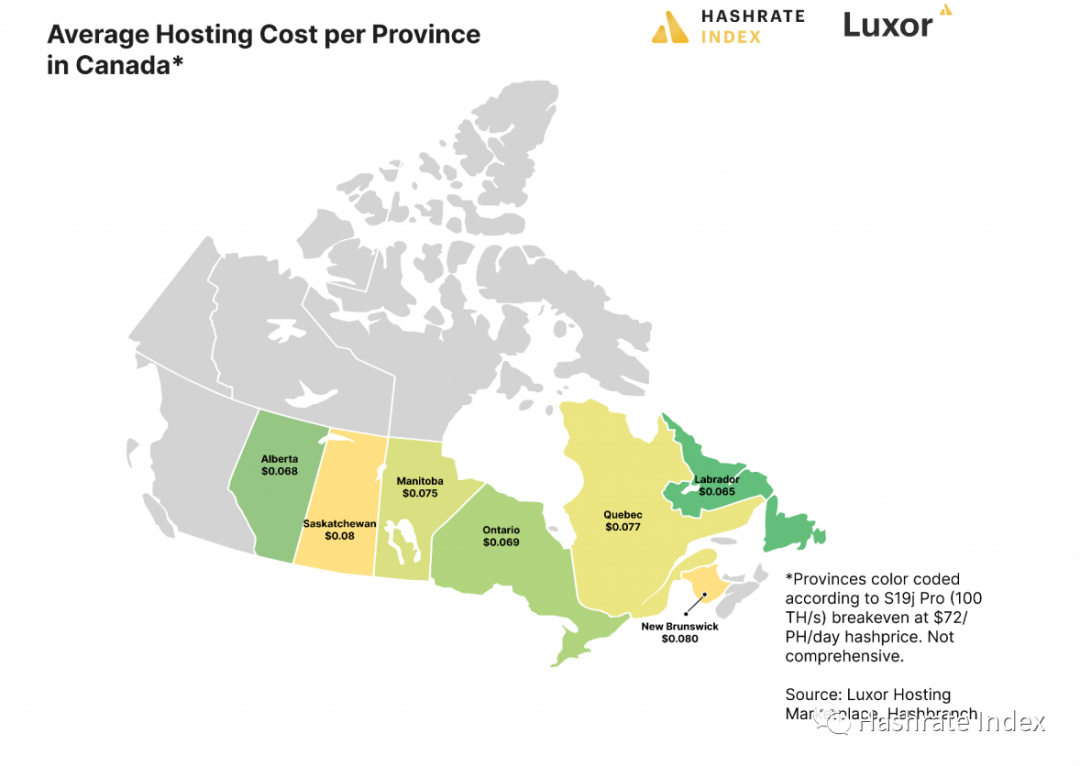
Figure 19: Average hosting electricity prices in Canadian provinces
Historically, hosting rates in Canada have been slightly lower than in the US. The country has abundant hydroelectric resources, but new miners have struggled to enter the market due to a lack of regulatory clarity (see the section on Canada at the end of this report). Operators in Labrador offer services at an average of $0.065 per kWh, the lowest hosting rate. Meanwhile, New Brunswick and Saskatchewan are the most expensive provinces, averaging $0.080 per kWh.
2. About Hosting
Since 2020, with the rise in natural gas prices, oilfield stations and stranded natural gas operators have generally increased their prices. Energy-saving measures and stranded natural gas operators are also increasingly inclined towards hashpower price economics, and after understanding the Bitcoin mining market, they are choosing a more balanced profit share; whereas miners used to receive 80/20 or 70/30 profit-sharing contracts, where natural gas operators would receive 20-30% of mining profits (or in some cases revenue), miners are now receiving 60/40 or 50/50 profit-sharing contracts. Stranded hosting sites are increasing their hosting rates as grid-connected natural gas increases. Hosting in hydro facilities can provide the best combination of uptime and cost.
The United States and Canada offer the most liquid and transparent hosting markets, hence the higher prices compared to other countries. Miners in Europe also seem willing to pay a premium, hosting their machines in locations relatively close to the Nordic countries, pushing up the retail hosting rates in the region to around $0.09 per kWh.
Generally, miners unwilling to pay a premium will seek hosting solutions outside of North America, such as in Paraguay or Russia, where hosting costs are much lower. Paraguay has not seen any significant changes in hosting fees in the past few months, with an average retail price of $0.0625 per kWh.
According to observations by Luxor's business team, hosting rates in Russia have slightly increased, with retail customer electricity prices averaging $0.055 per kWh. Over the past year or so, many miners from Europe and North America have withdrawn from Russia due to economic sanctions and the war in Ukraine. This exodus has left a vacuum in rack space, quickly filled by miners from China, Kazakhstan, Iran, Russia, and some adventurous Western countries. You can read more about the mining situation in these countries in Chapter 5.
So, what will happen to hosting fees in the coming months? Let's focus on the largest market - the United States. Like any other market, hosting rates are determined by supply and demand. In 2022, as electricity prices soared, supply shrank. Meanwhile, many Western miners withdrew from Russia due to the backlog of mining investments during the bull market in 2021, leading to strong electricity demand. We expect hosting rates to remain stable in the next quarter. Nevertheless, electricity contracts (especially for industrial consumers) will become more complex. For electricity operators, demand response, curtailment, and similar electricity management strategies will be key to maintaining low operating costs, especially before and after the halving. Some contracts, such as agreements for wind or solar mining farms, may offer low uptime (10-16 hours) for lower electricity costs ($0.03-4 per kWh); conversely, hosting at nuclear or hydro sites, where uptime can reach over 95%, may be more expensive ($0.06-8 per kWh).
Since the ban on mining in China, retail mining investors have become increasingly interested in Bitcoin mining in North America. Typically, these mining operations are on a smaller scale (possibly 1-10 machines), which means they may not have the same negotiating power with hosts or power companies for better rates. Therefore, all-in hosting/electricity costs above or equal to $0.075 per kWh for retail miners should evaluate their post-halving strategies.
3. The US Will Add 25.6 GW of Capacity in 2023
This section will cover general trends in the power supply chain and introduce some large power generation projects related to Bitcoin mining. While we will focus on the US, we will also mention some projects in emerging mining countries (such as the UAE and Finland).
Let's start by understanding the trends in the US power supply chain. The major trend in US power supply in recent years has been the replacement of coal with natural gas for base load generation, while rapidly expanding wind and solar capacity. This trend peaked in 2023, whether in the retirement of coal-fired power plants or the commissioning of solar power plants.
In 2023, solar energy will account for more than half of the planned increase in US electricity supply.
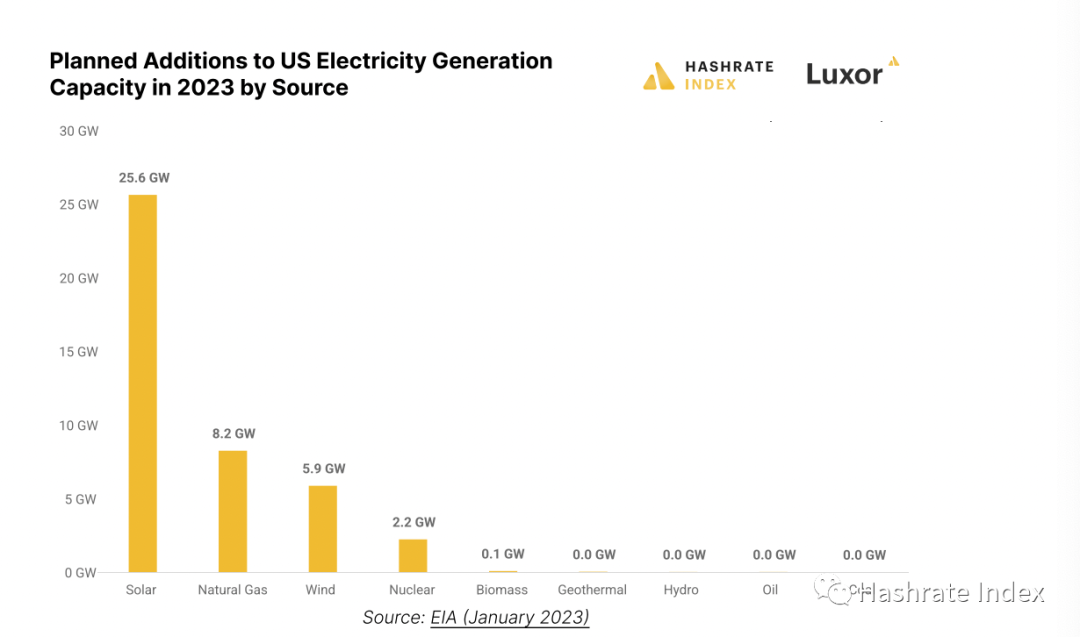
Figure 20: Expected increase in various components of US electricity supply in 2023
As shown in the above graph, the EIA estimates that developers will add 25.6 GW of solar, 8.2 GW of natural gas, 5.9 GW of wind, and 2.2 GW of nuclear in 2023. Meanwhile, we will not see any significant new power plant additions in biomass, geothermal, hydro, oil, or coal.
4. Will the European Electricity Market Experience Turbulence Due to Bitcoin Mining?
In recent years, miners have been flocking to the Nordic countries of Norway, Sweden, Iceland, and Finland, while avoiding the southern European countries with significantly higher electricity costs. However, if the electricity market returns to normal, mining may become feasible in other European countries.
As shown in the graph below, electricity prices in most European countries have sharply declined over the past year, with spot prices in France, Spain, and Germany dropping by over 50%. However, these countries' electricity prices still have a long way to go to be considered "friendly." The current spot price in France is $100 per MWh, almost double the highest mining fee threshold before the halving.
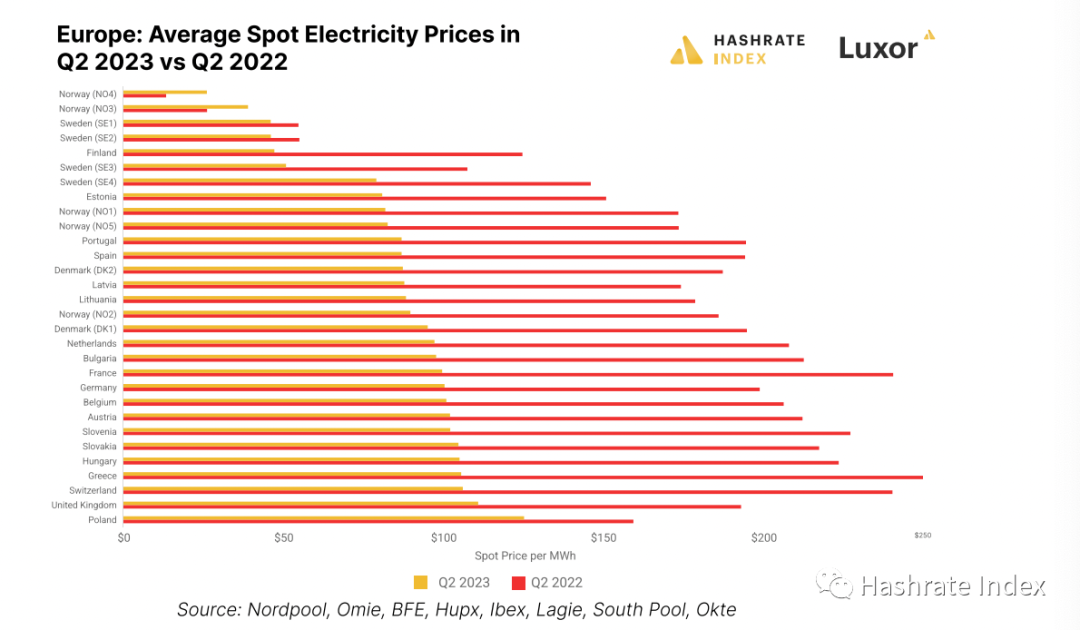
Figure 21: Comparison of average electricity prices in Europe for Q3 2022 and Q3 2023
Meanwhile, the spot electricity prices in the NO4 and NO3 price zones in the northernmost part of Norway averaged $26 per kWh and $39 per kWh in the second quarter of 2023, far below the highest Bitcoin mining cost threshold. Interestingly, during the European energy crisis in the second quarter of 2022, miners in this price area in Norway even received lower prices, paying only $13 per kWh and $26 per kWh in the spot market. In the hydro-rich northern regions of Norway, miners were actually shielded from the chaos in the European electricity market in 2022 due to limited high-voltage transmission connections to the European mainland.
It can be seen that miners in the price zones in the northernmost part of Sweden also enjoy relatively cheap hydroelectric resources, with prices at $46 per kWh. Companies in Sweden, such as Hive Digital Technologies and Prosperity Digital, were fortunate to escape the energy crisis due to transmission line restrictions.
Norway, Sweden, and Iceland have been mining powerhouses in Europe for many years, but Finland is emerging as a new mining star. The country recently launched the largest nuclear reactor in Europe, expected to output about 55% of the electricity. This large-scale nuclear investment, along with generally lower electricity prices, has reduced Finland's electricity prices by 62% over the past year, to a relatively competitive $47 per MWh. With abundant idle capacity and cheap electricity, Finnish regulations do not constrain the development of the mining industry, and over time, Finland may surpass Norway to become the largest Bitcoin mining country in Europe. Although electricity prices in other European countries have dropped significantly, they are still relatively high compared to Finland, making it difficult to prove their feasibility in the Bitcoin mining industry.
5. Europe Unlikely to Become a Bitcoin Mining Paradise, But We Remain Hopeful
European electricity prices are unlikely to continue to decline, but they will continue to face electricity supply issues in the upcoming winter. Futures contracts for delivery of electricity in Germany in 2024 and 2025 are priced at $153 per MWh and $161 per MWh, a significant increase compared to the current spot price of $101 per MWh.
The European energy market has serious structural problems that could lead to sharp increases in electricity prices at any time. For years, the European continent has severely underinvested in base load generation, leading to a fragile electricity market and significant price fluctuations.
Even if Europe is fortunate to experience an exceptionally mild winter again, these deep structural cracks in the European energy system will not disappear. Therefore, the high electricity price risk makes it impractical to invest in industrial-scale mining facilities in most areas of Europe, unless investors can somehow achieve long-term electricity price hedging, or prices miraculously drop over time.
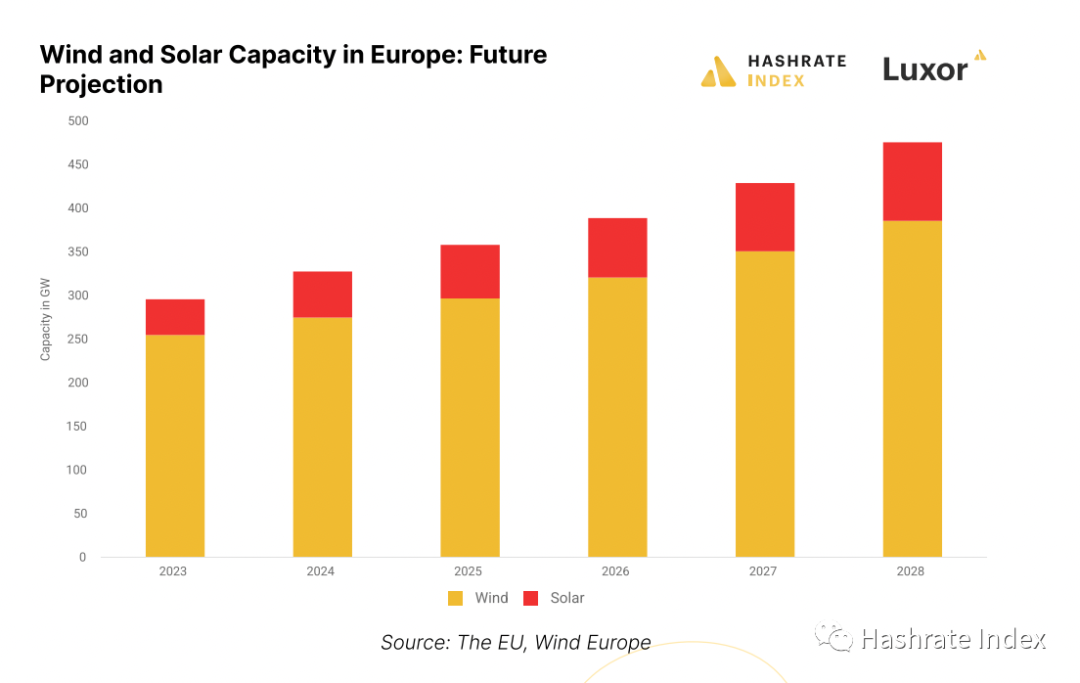
Figure 22: Forecast for the development of wind and solar energy in Europe
Even so, miners and energy producers can use smaller-scale Bitcoin mining operations to address various energy issues. For example, with a large investment in wind and solar power in Europe, the duration of negative electricity price periods is increasing, leading to greater price volatility. Bitcoin miners can absorb surplus solar and wind energy from the grid. For wind energy, output is usually at night and in the morning, while solar energy is in the morning.
The Bitcoin mining industry in Europe will continue to be concentrated in Norway, Sweden, Finland, and Iceland.
Listed Mining Company Stock Performance Rebounds
It is no exaggeration to say that Q2 2023 was a "resurrection season" for listed mining companies.
The stocks of listed mining companies suffered a disastrous defeat at the end of last year, with prices falling by 90-99%. However, in the first half of 2023, the stocks of these companies rebounded, with gains of several hundred percentage points (possibly). The stock rally peaked in July but gradually subsided thereafter.
This report only covers some data points for listed mining companies and provides high-level commentary on them. Since these mining companies will release their Q2-2023 10-Q reports in August, the data from Q1 in this report will soon become outdated. Therefore, we will reissue a stock report in August.
Listed Mining Companies Increase Bitcoin Sales Volume
In 2023, listed mining companies have continuously increased their Bitcoin production due to capacity expansion, providing support for the next phase of business expansion and deployment of next-generation mining equipment. In the early part of 2022, miners chose to hold onto Bitcoin and refused to sell. After the ripples from Terra Luna and FTX impacted the crypto market and affected hashpower prices, the hoarding of Bitcoin by listed mining companies significantly decreased. During the bull market, these companies could operate through a mix of debt and equity financing; however, in 2022, their stock values were only valued at a limited bull market valuation, and with the federal government raising interest rates, financing options dried up. As liquidity from these two sources gradually dried up, mining companies were forced to sell Bitcoin to meet their operational needs, often at prices below $30,000 per coin.
The graph below shows that Bitcoin sales volume peaked when Bitcoin first fell to $16,000 in June of last year. Most large-scale sales occurred with heavily indebted mining companies, who had taken out large equipment loans at the peak of machine prices, resulting in unsustainable debt.
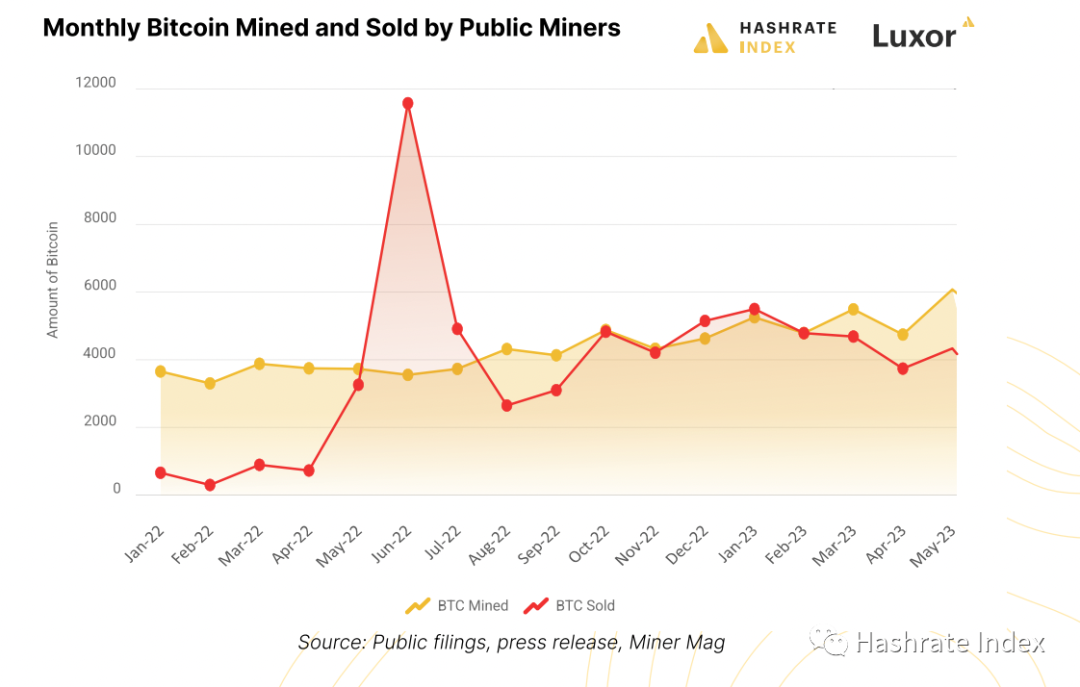
Figure 23: Overview of monthly Bitcoin mining and sales by listed mining companies
In May 2023, listed mining companies significantly increased their Bitcoin production. However, after June, production capacity saw a significant decline. In May, listed mining companies mined 6,079 Bitcoins; but in June, they only mined 4,859 Bitcoins. It is clear that the hot summer and higher network difficulty have affected overall mining efficiency.
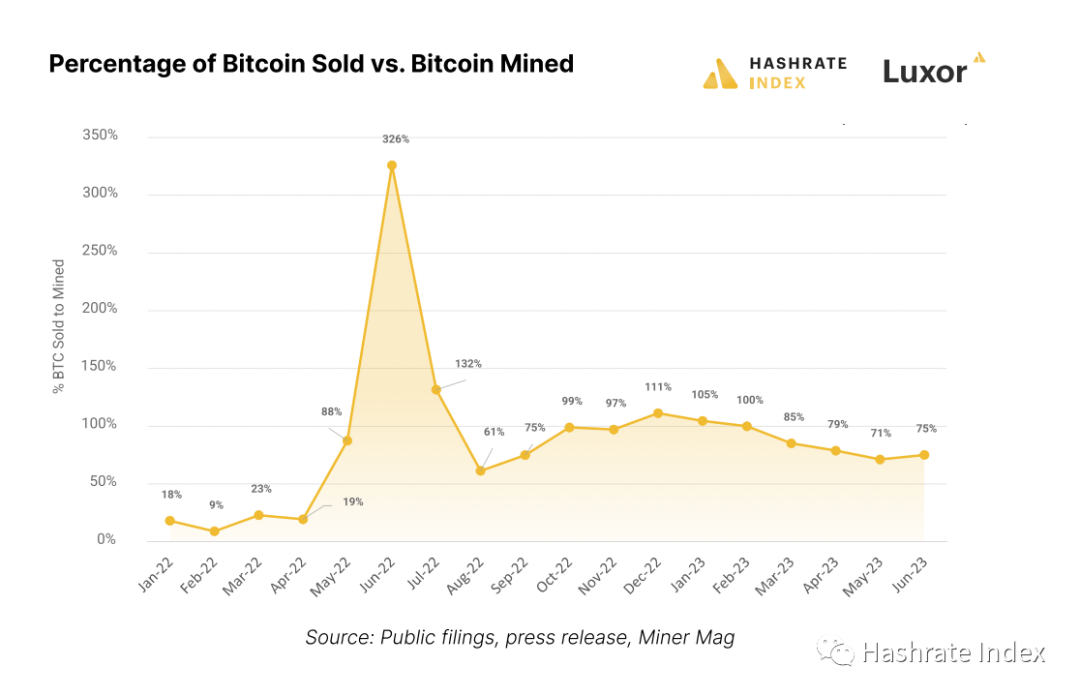
Figure 24: Overview of Bitcoin mining/sales volume ratio
In the first quarter of 2023, the average amount of Bitcoin sold by mining companies was higher than in the second quarter. As seen from the graph, the largest sales of Bitcoin occurred during periods of significant price drops. Most listed mining companies were selling off their entire Bitcoin inventory when Bitcoin reached its bear market low at the end of 2022. With the arrival of spring, mining companies made planned adjustments, with most of them starting to sell two-thirds of their Bitcoin inventory each month to fund their business operations and development.
It is expected that mining companies will continue to formulate financial management strategies to avoid making the same mistakes.
Listed Mining Company Marginal Production Costs
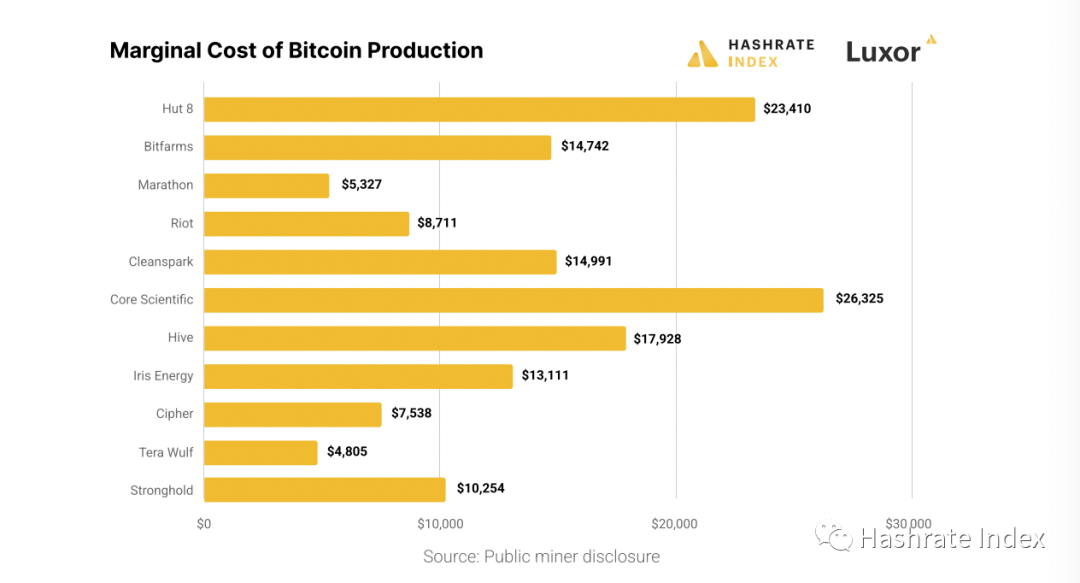
Figure 25: Bitcoin Marginal Production Costs
We calculated the marginal production costs of listed mining companies by dividing the revenue costs (excluding depreciation expenses) by the amount of Bitcoin mined during the period. The dataset is based on the latest quarterly financial reports of each company. According to current mining economics, most listed mining companies will still make some mining profits in the range of $15,000 to $20,000 per Bitcoin.
As a key point in the calculation of marginal production costs, we used the operating costs of mining companies in the first quarter to calculate their current mining capacity. For example, after the release of their second-quarter financial reports, Marathon Digital and Terawulf's marginal production costs may reach $10,000, and the marginal costs of other mining companies may also increase or decrease. We plan to continue refining this analysis in future reports.
Listed Mining Company Hash Rate Expansion
In the first half of 2023, most Bitcoin mining companies have completed their hash rate expansion. Iris Energy led the way with a 254% increase in hash rate, even though they did not fulfill their equipment loan repayment obligations last year. After the launch of its new facility in North Dakota, Marathon Digital's hash rate capacity increased by 152%. In March of this year, after the Lake Mariner facility began operations, Terawulf's mining capacity increased by 80%. Bitfarms increased its mining capacity by 70% by utilizing the full power of 50 MW at its licensed data center in Argentina. Greenidge solved its equipment loan issues from last year and successfully increased its mining capacity by 127%, becoming the "dark horse" of 2023.
It is expected that the hash rate of major listed mining companies will continue to increase significantly. Cleanspark deployed a large number of mining facilities in July, increasing its hash rate capacity from 6.7 EH/s to over 8.5 EH/s. Marathon Digital's Garden City will begin operations in August, and with the expansion in North Dakota, its total capacity is expected to increase by 21-23 EH/s. Hut 8's hash rate will double after completing the acquisition of US Bitcoin. Finally, Core Scientific is currently undergoing restructuring, and hash rate expansion will have to wait until it emerges from bankruptcy.
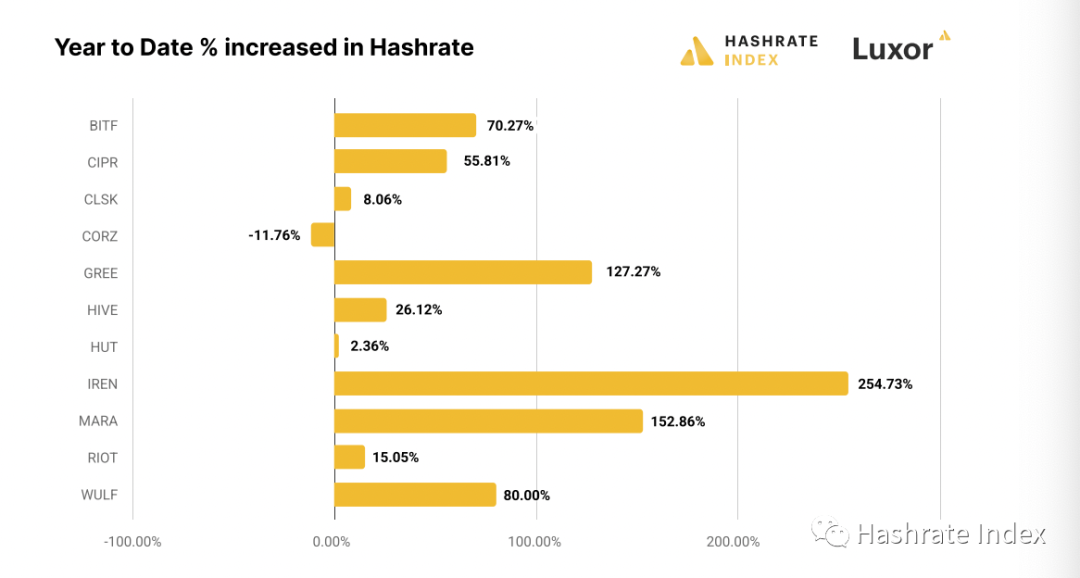
Figure 26: Overview of hash rate increases for major listed mining companies from January to July 2023
Beware of Blindly Following the AI Trend
This industry is no stranger to hype and following trends, which has led to a wave of AI hype.
With the emergence of ChatGPT, Midjourney, and other artificial intelligence tools, some miners are using the promotion of their high-performance computing and/or AI capabilities to create hype.
High-performance computing is a general term used for any data center function. However, when miners talk about high-performance computing, they specifically refer to cloud computing, graphic rendering, and similar high-computing tasks. Hut 8 generated $4.5 million in revenue from these services in the first quarter, while HIVE's pilot project brought in $230,000 in revenue for the company.
In reality, the cost of an artificial intelligence data center may be 10 to 20 times that of a Bitcoin mining farm and may incur higher double electricity costs in operation (up to $0.15 per kWh). Computing devices such as Nvidia's A100 and H100 GPUs cost tens of thousands of dollars each. Additionally, these data centers require more cooling and backup power infrastructure.
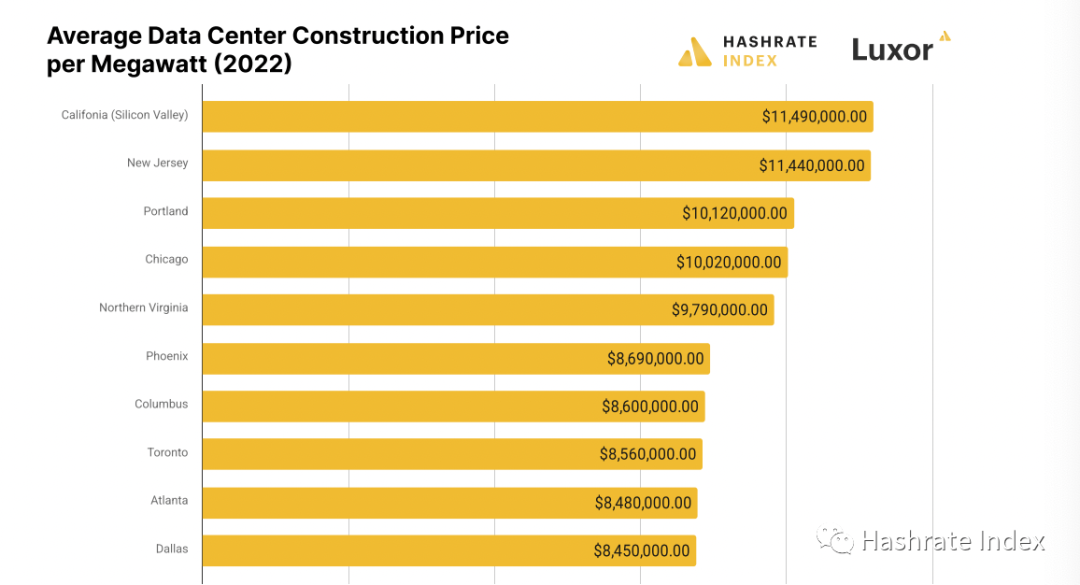
Figure 27: Cost per megawatt of power for data centers
Riot estimated its upcoming Corsicana facility, with a power cost of $832,000 per megawatt and a total cost of $330 million for a facility capacity of 400 MW. In contrast, the average cost in Turner and Townsend's 2022 Data Center Index is only $9.5 million per megawatt.
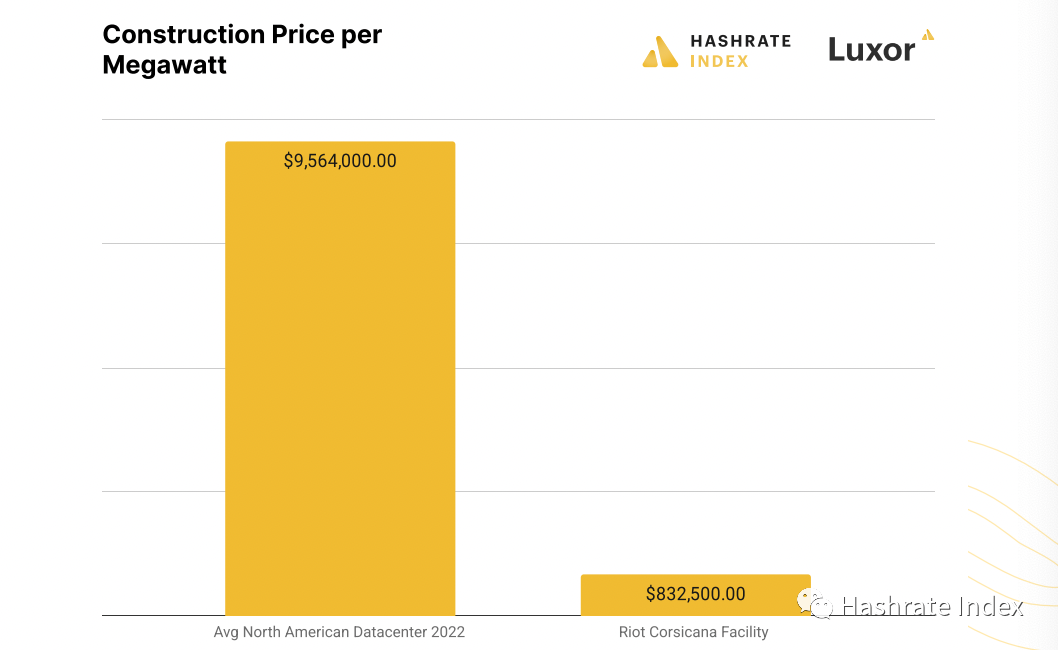
Figure 28: Comparison of power costs per megawatt for Riot Corsicana and other data centers in North America
Apart from machines that can provide GPU graphic rendering services, no miner would use their computers for Chat-GPT. Therefore, when you see headlines or press releases about AI, don't believe them too much, as it is not what you imagine.
Bitcoin Mining Landscape in Various Countries
In this section, we outline the Bitcoin mining landscape in countries with significant or noteworthy mining activities. As other parts of our report delve into the North American market rather than providing a high-level overview of mining activities in the United States and Canada, we summarize recent regulatory actions that have impacted the industry.
United States
Overall, Bitcoin, Bitcoin mining, and cryptocurrencies have become increasingly real in the United States in 2022 and 2023. This is particularly evident in the Bitcoin mining industry, especially in aspects related to traditional capital markets and regulatory aspects. The second quarter of 2023 saw some positive progress in both areas.
For example, a significant amount of ESG pressure accumulated during the last bull market has dissipated. The cultural war has cast a shadow over almost every social, economic, and political topic in this country, but currently, no party has implemented policies at the national level that have seriously harmed the industry.
Nevertheless, the current government and Congress are still working on it. The industry has escaped some enforcement and legislative attempts aimed at imposing excessive taxation or additional regulatory burdens on the Bitcoin mining industry. In particular, Biden's Digital Asset Market Participant Tax, which would increase the tax burden on Bitcoin miners to 30%, has been shelved after the continuously rising debt ceiling agreement reached in Congress. Instead, the CHIPS Act has sparked a frenzy of states vying to find suitable land to accommodate chip manufacturing plants and data centers.
As the DAME tax is currently on hold, there is no information to report on industry developments in the federal-level conference in the last quarter, but there are many actions at the state level worth discussing.
1. State Bills
In addition to federal regulations that may affect Bitcoin miners, individual state regulations may have a significant impact. The separation of powers in the United States ensures that certain state laws override federal laws (marijuana is one example, and an extreme example is the potential differences between state and federal laws).
In 2023, historically conservative states enacted the so-called "mining rights" wave, which stipulates that as long as miners comply with local and state laws and regulations, they must not discriminate against miners. These laws are the first domestic laws involving Bitcoin mining and provide clear guidelines for regulation.
Other states have introduced neutral to negative legislation in this quarter and in the past, but most have not been specifically implemented or have failed.
2. Texas
One of the more alarming pieces of legislation comes from the mining mecca of the United States - Texas.
On April 12, the Texas Senate passed Bill 1751. A bipartisan group of senators from the Texas Senate Business and Commerce Committee introduced the bill in March this year, which, among other things, restricts the demand response level that Bitcoin miners in the state can provide and prohibits them from using certain property tax exemptions applicable to industrial-scale enterprises. The main sponsor of the bill often receives campaign funds from energy companies that invest in peak power plants. Peak power plants are natural gas power plants that only operate during peak demand periods. Bitcoin mining farms have become competitors to peak power plants due to their ability to provide flexible loads to the grid, and these measures will be a heavy blow to the Bitcoin mining industry in Texas.
The bill is awaiting a vote in the House, and many critics and miners expect it to be vetoed.
3. Arkansas
Arkansas passed legislation to regulate the Bitcoin mining industry as part of its 2023 "Arkansas Data Center Act." This bill, now known as Bill 851, provides specific directions for Bitcoin miners to ensure that they can operate in the state by complying with the following regulations:
a. State business and tax laws
b. Local and state operational, safety, and noise pollution regulations
c. Any rules or rates for utility services provided by public entities and the state
d. State and federal employment laws
The reaction to the bill is mixed, with some counties attempting to oppose it.
4. Mississippi
In February of this year, the Mississippi Senate passed SB 2603, its own "mining rights." Unfortunately, the Mississippi House of Representatives vetoed it in April.
5. Missouri
In March 2023, both houses of the Missouri Senate and House of Representatives passed their own "mining rights" bill - SB 692, but Governor Parson has not approved it. The bill will ensure that Bitcoin mining farms are given the same treatment as traditional data centers and prohibit any state and local legislation against mining in residential or industrial areas. Additionally, it exempts cryptocurrency from state and local taxes. If Parson approves the bill, it will take effect on August 28, 2023.
6. Montana
Montana passed a "mining rights" bill similar to Arkansas, which stipulates that Bitcoin miners can operate in the state "without undue discrimination or requirements." Governor Gianforte signed the bill on May 2, 2023.
7. Oregon
Oregon lawmakers attempted to push through Bill 2816 in the last quarter, which aimed to impose emission targets on Bitcoin mining and data centers. The bill failed to pass committee review in April after Amazon announced plans to build five new data centers in the state.
8. Pennsylvania
Pennsylvania Bill 1476 was referred to the state's lower house in June. The bill proposes a temporary halt to Bitcoin mining's power consumption and indicates that a study will be conducted on the environmental impact of Bitcoin mining.
9. Washington State
In the last quarter, Washington State took strict measures to regulate data centers and Bitcoin mining farms. Governor Jay Inslee signed Washington State Bill 1416 on May 3, 2023. The law establishes emission limits for data centers and Bitcoin mining farms, consistent with the state's green energy goals set in 2021.
Canada
Similar to the United States, Canada also has federal government regulations, with most regulations governing Bitcoin mining being at the provincial level. Before the mining ban in China, this country of deer, maple trees, and hockey was a leader in Bitcoin mining in North America.
In November and December of last year, some Canadian provinces implemented an 18-month pause on new mining power contracts, seemingly as a coordinated effort to prevent miners from expanding in energy-rich areas of Canada. Miners have found it increasingly difficult to expand or enter the Canadian market, not to mention that the Canadian federal government has also raised carbon taxes; one of the highest carbon taxes in the world, at around $30,000 CAD per megawatt.
It is worth noting that electricity imports are not affected by carbon taxes, and Canadian power companies also export a large amount of electricity to more populous American cities (Canada has a population of 38.25 million, the United States has a population of 331.9 million, but the installed capacity per 1000 citizens is 4 megawatts, 19% higher than the United States' 3.4 megawatts per 1000 citizens). In most cases, Canadian power companies make more money selling electricity to American cities than they would by selling it to local power consumers such as Bitcoin miners.
Finally, Canadian officials have proposed implementing a "shadow tax" that would prevent Bitcoin miners (and other data center operators) from receiving input sales tax credits like other export industries.
If the proposal is passed, companies engaged in digital asset development would no longer be eligible for input tax credits for value-added tax. This unprecedented proposal would impose an implicit tax, increasing Bitcoin mining costs by 5%-15%, significantly reducing Canada's competitive advantage.
In response, Canadian miners have formed the Responsible Digital Asset Development Fair Taxation Alliance. So far, they have successfully halted proposed changes and have been pleading with officials for industry consultations to understand digital asset development and how to promote a healthy Canadian digital mining industry through fair taxation and regulation.
In addition to the above alliance, the Canadian Blockchain Alliance is a recently formed organization composed of cryptocurrency, Bitcoin, and mining industry professionals, which has been educating policymakers and pushing back against excessive policies.
1. Alberta
Alberta, known as a cowboy province, often plays a contrarian role and is trying to incorporate Bitcoin miners into the electricity market.
This oil-rich province has taken action to attract Bitcoin miners, while other provinces are avoiding this trend. In addition to its abundant oil resources, Alberta's energy market is relatively less regulated compared to socialist provinces like Hydro-Quebec, making it a free market.
Although there is no specific legislation at the moment, the Alberta government has expressed its desire to push policies to make Alberta a "modern electricity powerhouse."
2. British Columbia
B.C. Hydro, the electricity management agency in British Columbia, implemented its own 18-month pause on new mining power contracts in December of last year. At the time, it stated that it had received requests from 21 mining companies for 1.4 GW of power contracts, while it currently only serves 7 mining companies with a total load of 273 MW.
3. Quebec
In December 2022, Hydro-Quebec, the power company in Quebec, canceled approximately 270 megawatts of power contracts previously awarded to Bitcoin mining companies. The power company has a habit of implementing a stop-and-go mechanism for new Bitcoin mining contracts, making it difficult for new Bitcoin miners to establish themselves in the region. Even established miners with similar previous power contracts, such as Bitfarms, have left the province when Hydro-Quebec refused to grant new power purchase agreements for expansion plans.
With its abundant hydroelectric power, Quebec became an early mining hub. In 2022, it exported 16.5% of its output. According to the power management agency's 2022 report, Hydro-Quebec sold 216.2 billion kWh of electricity in 2022, with 35.6 billion kWh exported, mainly to major cities in the northeastern United States, such as New York, at an average price of $0.082 per kWh.

Figure 29: Hydro-Quebec power sources and sales
4. Manitoba
Manitoba implemented an 18-month pause on new Bitcoin mining projects in December 2022.
5. New Brunswick
New Brunswick implemented a pause on new mining contracts in March 2022.
6. Newfoundland and Labrador
Newfoundland and Labrador have not taken any action against Bitcoin mining companies in the past few years, making this province one of the most promising mining areas in Canada.
Latin America and Paraguay
As Bitcoin miners in the Western Hemisphere seek cheaper electricity, Paraguay is emerging as a leader in mining in Latin America.
In addition to Paraguay, Argentina, Uruguay, and Brazil are also becoming promising mining countries. Colombia and Venezuela also have a small number of mining sites, but these countries lack economic and political stability, making it difficult for most miners to bear the risk, even with the lowest electricity prices, and import tariffs may not be easy to handle.
This section mainly focuses on Paraguay, the largest Bitcoin mining center in Latin America.
Since the turmoil in Venezuela, Colombia, and Argentina has prevented miners from establishing operations in these former hotspots, Paraguay has risen in Latin America. It has filled the void with the Itaipu Dam.
Second only to China's Three Gorges Dam, the Itaipu Dam can generate 14 gigawatts of power. Since its commissioning on May 5, 1984, the dam has provided electricity to Paraguay, Brazil, and Argentina, jointly owned by Brazil and Paraguay.
Paraguay gets over 99% of its electricity from the Itaipu Dam and its "cousin," the Yacyretá and Acaray dams. However, with a population of 6.7 million, Paraguay cannot consume all the energy produced by its dams, leading to it exporting 90% of its energy to neighboring countries Brazil, Bolivia, and Argentina.
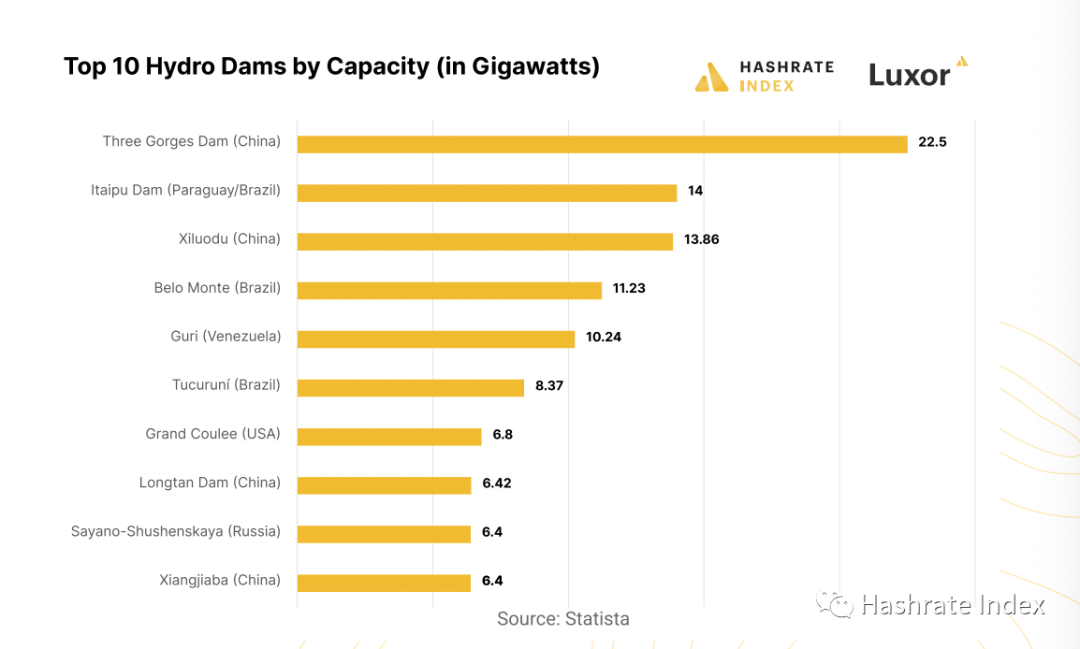
Figure 30: Top 10 Dams in the World (Ranked by Capacity)
Paraguay's state-owned power utility ANDE has what miners see as liquid gold, and they know it. Last year, the Paraguayan Congress passed a bill that leans towards Bitcoin, officially regulating miners and reducing electricity payment rates. President Benítez vetoed the bill, and when it returned to Congress from the president, the vote was postponed for a year due to the lack of a sufficient quorum. However, miners have not been deterred and continue to flock to Paraguay. There are reports that the power sector in Paraguay is preparing at least six 100 MW contracts for industrial-scale miners, some of which are listed mining companies, such as Bitfarms.
Bitfarms has signed a long-term power contract for 150 MW, with 50 MW allocated to its existing Vilarrica mining site, and the remaining 100 MW for a new site near the Itaipu hydroelectric plant.
Undoubtedly, Paraguay is highly attractive to miners, but miners need the right connections to navigate Paraguay's somewhat complex licensing and registration requirements. Bitcoin miners must establish a limited liability company to import Bitcoin mining hardware in bulk, and they must pay a certain amount of electricity deposit for their power contracts. Additionally, they need to obtain permits to import the necessary cables and other electrical equipment to maintain mining operations. The cost of importing mining machines can be 17-20% of the machine's market price (a bargain compared to the 50-80% import tariffs miners pay to import machines to Brazil and Argentina, or the additional bribes required in places like Venezuela and Colombia). Furthermore, miners need a permit from the Ministry of Commerce to build Bitcoin mining sites, but this permit can be obtained within a few days. Finally, Bitcoin miners must pay an environmental tax to remain compliant.
Unless the government takes any drastic action or there is overall social and political instability, Paraguay's position in the mining industry in Latin America is likely to continue to consolidate in the coming years.
Bitcoin Mining Gradually Accepted in Russia
Bitcoin mining in Russia, like in most countries, has grown and operated in a wild manner without regulation. However, recent discussions between the Russian mining community and various departments indicate that the Russian government is seeking to regulate this industry.
The Ministry of Energy, the Ministry of Finance, and the mining industry itself are all pushing for industry regulation. The regulations will provide three main advantages for the mining industry and related regulatory agencies.
First, it will establish a tax system, clarifying the amount of tax miners should pay and to whom the taxes should be paid. Second, it will simplify the corporate structure of Russian mining companies, as the current accounting law does not accept Bitcoin income, preventing Russian miners from conducting personal mining through Russian entities. Third, and most importantly, the industry under regulation will be more attractive to investors, allowing listed mining companies to be listed on the Moscow Stock Exchange and engage in market lending. Many Russian investors and financial institutions want to invest in the mining industry, but because the industry is not yet regulated, they are naturally rational to put their investments on hold.
Another interesting aspect of the upcoming mining regulation is that it may prohibit or strictly limit household mining. This is because household mining has already caused problems for certain Russian city power grids. Due to its negative public relations impact, BitRiver CEO Igor Runets is leading efforts to restrict household mining.
However, such comprehensive regulation will not be implemented overnight, especially considering the different viewpoints of government departments such as the Ministry of Energy, the Ministry of Finance, and the Central Bank of Russia on how to proceed with the issue. For example, while the Ministry of Finance wants miners to pay additional taxes on profits, the Ministry of Energy suggests that miners should not pay corporate income tax or value-added tax, but should be heavily taxed based on their electricity consumption. One thing seems certain: after regulation, Russian miners are likely to see an increase in their taxes, whether it's additional corporate income tax or electricity taxes. The Russian government plans to develop regulations for Bitcoin mining around 2024. Even though Bitcoin mining has been a relatively insignificant industry compared to oil and gas or traditional mining in the past two years, the Russian government still seems very concerned about this emerging industry, likely due to its future strategic importance.
One highlight at the St. Petersburg International Economic Forum was the explanation by the Russian Ministry of Finance of the Russian government's strategic plan to use mining as part of its domestic and international payment solutions. The specific idea is that miners must sell the Bitcoin they mine to Russian banks in exchange for digital rubles (Russia's CBDC). Therefore, miners will help drive the circulation of digital rubles while providing liquidity for the Russian central bank.
The Russian bank will use these Bitcoins for international transactions in close cooperation with the Russian government, likely to avoid sanctions. This strategy is similar to what the Iranian government has done in the past.
Kazakhstan
Over the past year and a half, a Kafkaesque bureaucratic process has weakened Kazakhstan's once great Bitcoin mining industry, which is now not as strong as before. Since the partial power cuts at the end of 2021, miners in Kazakhstan have been hoping that the Bitcoin mining regulations set to be implemented on April 1st will provide better regulatory clarity and operating conditions. However, things do not seem to have improved.
Northern Europe
Norway, Sweden, and Iceland have long been favored destinations for Bitcoin miners in Europe due to their cheap, renewable energy and relatively simple business environment. Recently, Finland has also joined the ranks, becoming an attractive Bitcoin mining country. In this section, we will summarize the most important trends and recent events in the Bitcoin mining industry in Northern Europe.
1. Summer is the Low Electricity Price Period for Northern European Miners
The main selling point of Bitcoin mining in Northern Europe is the stable, low electricity prices provided by abundant hydroelectric power in northern Norway and Sweden. So how have electricity prices changed in these regions in 2023?
These countries (excluding Iceland) have relatively liberal electricity markets, making it very easy to compare historical spot electricity prices. As seen from the chart below, these countries had very low electricity prices in 2023 compared to countries in southern Europe. As usual, the monthly average spot prices in northern Norway ranged from $0.020 to $0.047 per kilowatt-hour.
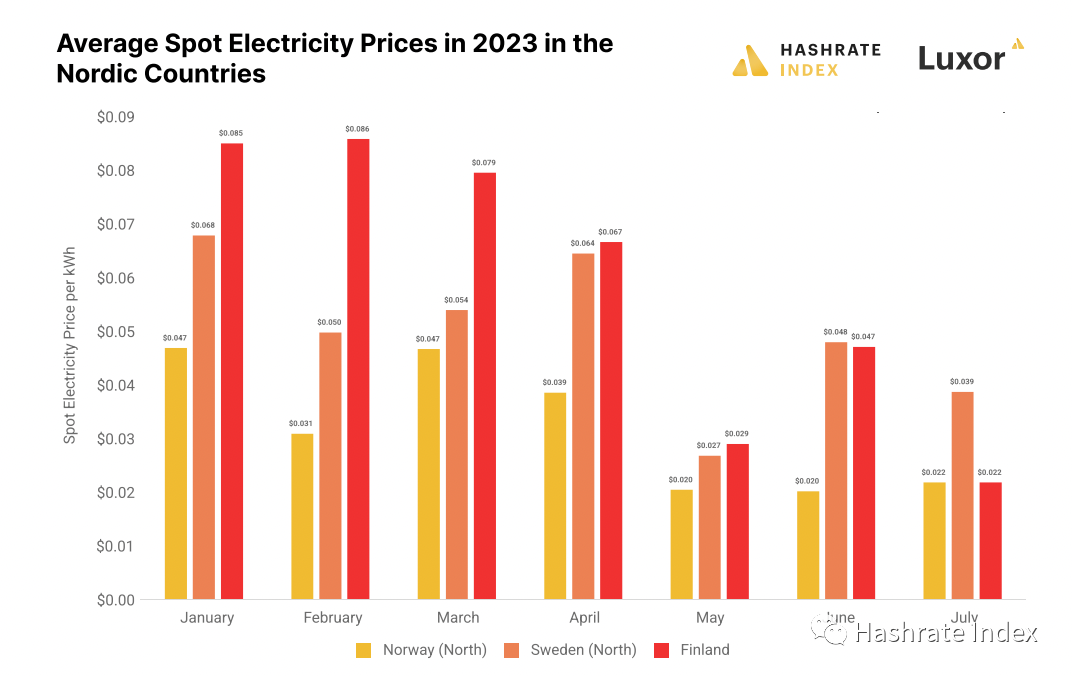
Figure 31: Average spot electricity prices in Northern European countries
Although not as low as northern Norway, Bitcoin miners in northern Sweden can also obtain highly competitive electricity prices. In 2023, the monthly average spot electricity prices in the northernmost region of Sweden fluctuated between $0.027 and $0.068 per kilowatt-hour.
Meanwhile, Finland, which has been severely affected by the energy crisis, has experienced a continuous decline in electricity prices in 2023, with the average price in July dropping to $0.022 per kilowatt-hour.
As the electricity market in Iceland follows a utility structure, Bitcoin miners must negotiate power purchase agreements directly with local utility companies, so we do not have access to their electricity price data. However, due to the island's abundant hydro and geothermal resources, we expect that its electricity prices will not change significantly.
It can also be seen from the chart that electricity prices in all Northern European countries have been steadily declining since January. This phenomenon is completely normal in the region for two reasons. First, the gradually rising temperatures lead to a significant decrease in heating demand. Second, the melting of snow in the mountains of Norway and Sweden leads to a sharp increase in hydroelectric power generation and a significant increase in electricity supply.
It is expected that electricity prices in Northern Europe will remain very low at least until November.
If you want to learn more about mining in Finland, please read this article. If you want to learn more about mining in Sweden, please read this article. If you want to learn more about Bitcoin mining in Iceland, please read this article. If you want to learn more about mining in Norway, please read this article.
Middle East
The Middle East is rapidly emerging as one of the fastest-growing Bitcoin mining regions. This article mainly discusses the Gulf countries on the Arabian Peninsula, including the United Arab Emirates, Saudi Arabia, Kuwait, Oman, Qatar, and Bahrain.
These countries have great potential in Bitcoin mining due to their abundant energy resources, high level of business friendliness, and strong desire for economic modernization.
1. Why the Middle East Can Become a Bitcoin Mining Hotspot
The power systems in Middle Eastern countries are perfectly suited for Bitcoin mining. In these hot and dry countries, up to 70% of energy consumption is used for cooling and freshwater production. However, there is a significant seasonal fluctuation in temperature between the hottest and coldest months, leading to a huge seasonal fluctuation in the electricity consumption of all air conditioners. Due to this consumption pattern, the basic demand in winter is about half of the peak demand in summer.
These seasonal fluctuations naturally put pressure on the power systems. Power plants cannot reduce production in winter to match the lower demand, making the situation even more challenging. This is because these countries use combined cycle and desalination units for desalinating seawater. Due to the critical need for delivering freshwater, these units must operate at relatively continuous capacity throughout the year, even though there is a huge fluctuation in electricity demand between the hottest and coldest months. This leads to a large amount of wasted electricity. Bitcoin miners can provide the necessary base load for these power systems and monetize the excess generated electricity, stabilizing the grid and increasing practical income.
Historically, almost all electricity consumption in these countries has come from natural gas. However, in recent years, they have been steadfastly trying to diversify their power supply through other sources such as nuclear, wind, and solar energy. The UAE recently launched the largest nuclear power plant in the Arab world, with a capacity of 5.4 GW, and plans to build the world's largest solar power plant with a capacity of 5 GW by 2030. Other countries in the region have similar plans to expand their power generation capacity, with Saudi Arabia having the most ambitious plans.
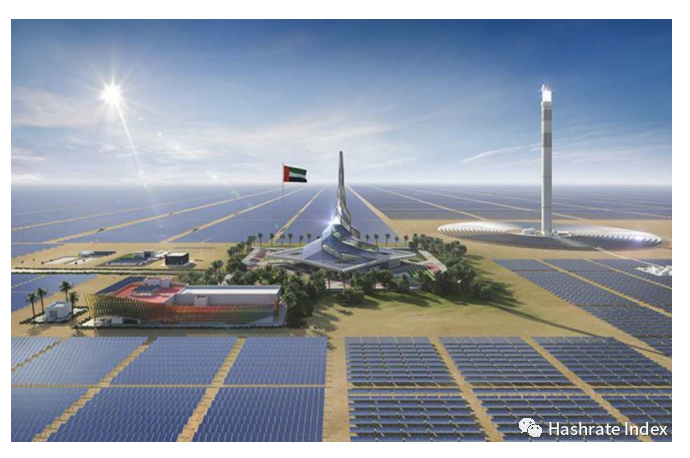
Figure 32: Mohammed bin Rashid Al Maktoum Solar Park
Asia
Until 2021, China has been the center of the Bitcoin mining industry, with 50-70% of the global total hash rate.
Now, mining has not completely left China, and the country still dominates in Asia. However, after the mining ban, a significant amount of hash rate has flowed out of China to neighboring countries.
We will cover some of these countries in this section, while also providing a brief overview of the latest developments in the Chinese mining circle.
1. China
China implemented a Bitcoin mining ban in various provinces in the summer of 2021, but this did not completely extinguish the industry. It is estimated that up to 20% of the hash rate may still be in China.
In fact, miners with political connections (or those who can continue to operate without special privileges) are still conducting mining operations in the region, and dams in the Sichuan region and elsewhere are still the focus of most mining activities.
During the rainy season (May to September), electricity prices range from $0.03 to $0.035 per kilowatt-hour. Since household mining is still officially banned in the country, most mining activities are small-scale (1-2 MW).
When China dominated Bitcoin mining, it was difficult for Western observers to gain insight into the situation, and it remains so. What we do know is that the scale of mining farms is much smaller now than before the ban, and those miners still in operation are usually closely connected to the central government and are part of a privileged class allowed to operate within certain limits.
A significant portion will continue to remain in China, and a considerable amount of Bitcoin's hash rate is expected to continue to come from China in the foreseeable future.
2. Bhutan
This quarter, Bhutan's investment institution (DHI) finally confirmed that they have been using their untapped hydro resources for Bitcoin mining for many years. It is said that this long-time mining country began mining Bitcoin when the price was only $5000. Now, after publicly disclosing its business operations, this mountainous country hopes to take its mining industry to new heights.
Bhutan recently announced that they have reached an agreement with Bitdeer to expand their Bitcoin mining capacity to 600 megawatts within three years, with the first phase project capacity of 100 megawatts set to launch in September. Bitdeer is currently raising $500 million from international investors to support the project. Several factors make Bitcoin mining a wise choice for Bhutan. First, due to its huge hydro resources, Bhutan's electricity exceeds what it knows how to handle. Historically, the country has exported most of its surplus hydroelectric power to India. However, over-reliance on one industry and one trading partner is very dangerous, and Bhutan has little bargaining power in negotiations with India. Therefore, instead of just exporting it to India, Bhutan can mine Bitcoin by using its hydro resources for domestic power generation, converting it into higher value, thus achieving economic diversification.
Bhutan currently has 2.4 gigawatts of hydroelectric power capacity and plans to open two new power stations with a total capacity of 1.4 gigawatts by the end of 2024. This capacity growth further increases the country's electricity surplus. With Bhutan and El Salvador leading the way in national Bitcoin mining, we expect other countries to follow suit in the coming years.
Conclusion
As Bitcoin miners approach the fourth halving, the game is changing rapidly. Hash power is spreading to new geographical areas, electricity management strategies are becoming more mature, and miners are also working to open up new capital pools and financing paths.
It is difficult to imagine what the Bitcoin mining industry will look like after the next halving. However, with block rewards reduced to 3.125 BTC, the profitability of high-cost miners will be greatly reduced, and some may even shut down their machines and exit the network. Therefore, we expect to see some serious hash rate restructuring. On the other hand, further growth in production will occur in emerging mining areas such as Latin America, the Middle East, and Russia in the foreseeable future. This is not to say that North America will not maintain an important share of network hash rate. It's just that if hash rate prices are low enough, miners of all scales will start looking for opportunities elsewhere.
Some Bitcoin holders, including miners, believe that the price fluctuations of Bitcoin are linked to the inflation of the halving cycle. Miners should carefully hedge their bets, strategize for the situation after 2024, and look for ways to improve machine efficiency, reduce power costs, or reduce other operating costs. The best time to plan for the halving was during the current halving period that began on May 11, 2020. But now is also a good time for miners to creatively seek opportunities if they cannot lock in low-cost power contracts or hosting agreements. Hedging strategies for electricity and hash rate prices are crucial for dealing with the future. Bitcoin's price may change before and after the halving, so it is wise to consider multiple possibilities when simulating the future.
免责声明:本文章仅代表作者个人观点,不代表本平台的立场和观点。本文章仅供信息分享,不构成对任何人的任何投资建议。用户与作者之间的任何争议,与本平台无关。如网页中刊载的文章或图片涉及侵权,请提供相关的权利证明和身份证明发送邮件到support@aicoin.com,本平台相关工作人员将会进行核查。




